1lumen selects and reviews products personally. We may earn affiliate commissions through our links, which help support our testing.
Weltool T1 Pro TAC review
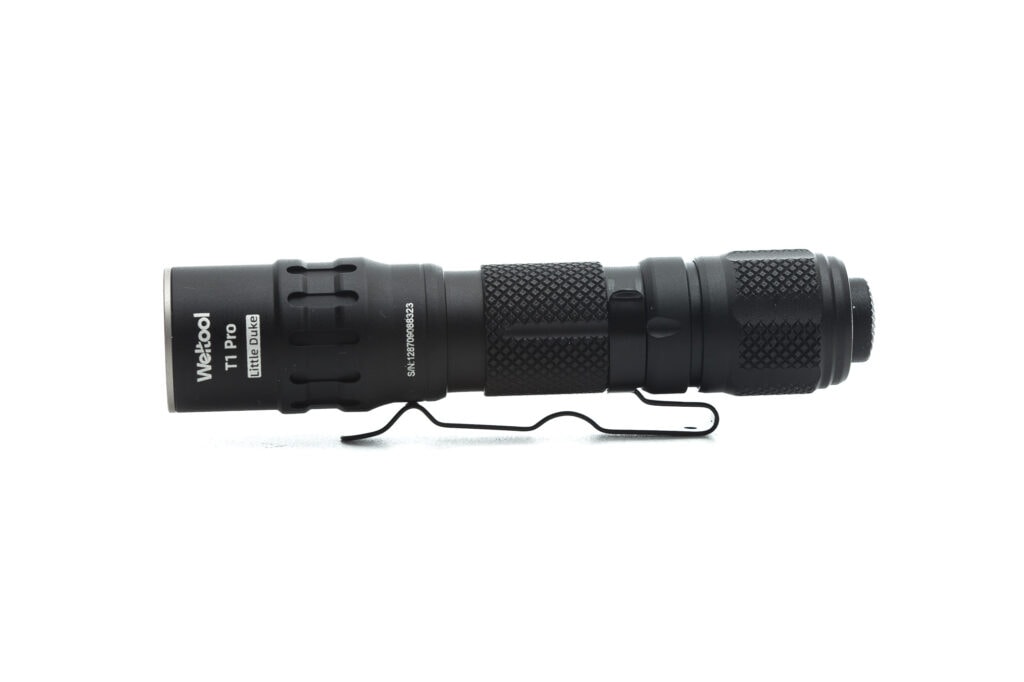
Weltool T1 Pro TAC specifications
| Brand/model | Weltool T1 Pro TAC |
|---|---|
| Flashlight category | Small tactical flashlight |
| LED | High density X-Led |
| Max. output | 540 Lumens (14500) 160lm (AA) |
| Max. beam distance | 290 meters |
| Max. beam intensity | 21,060 cd |
| Battery config. | 14500 / AA |
| Onboard charging | N/A |
| Modes | 2 |
| Blinkies | N/A |
| Waterproof | IP67 |
| Review date | February 2024 |
Review intro:
If you’re into tactical flashlights, you have probably heard of Weltool. If not… you’ll be surprised because they are an established company with lots of great flashlights.
This time we are looking at their new T1R Pro Tac, a small 14500-type tactical flashlight with a claimed output of 540 lumens.
So let’s check how this little flashlight is worth carrying the name: tactical flashlight
What’s in the package
This is what’s inside:
- Weltool T1 Pro TAC
- Weltool UB14-09 14430 battery (about same size as 14500)
- O-ring
- Manual
ps. Don’t forget to remove the plastic insulator in the tailcap before your first use.
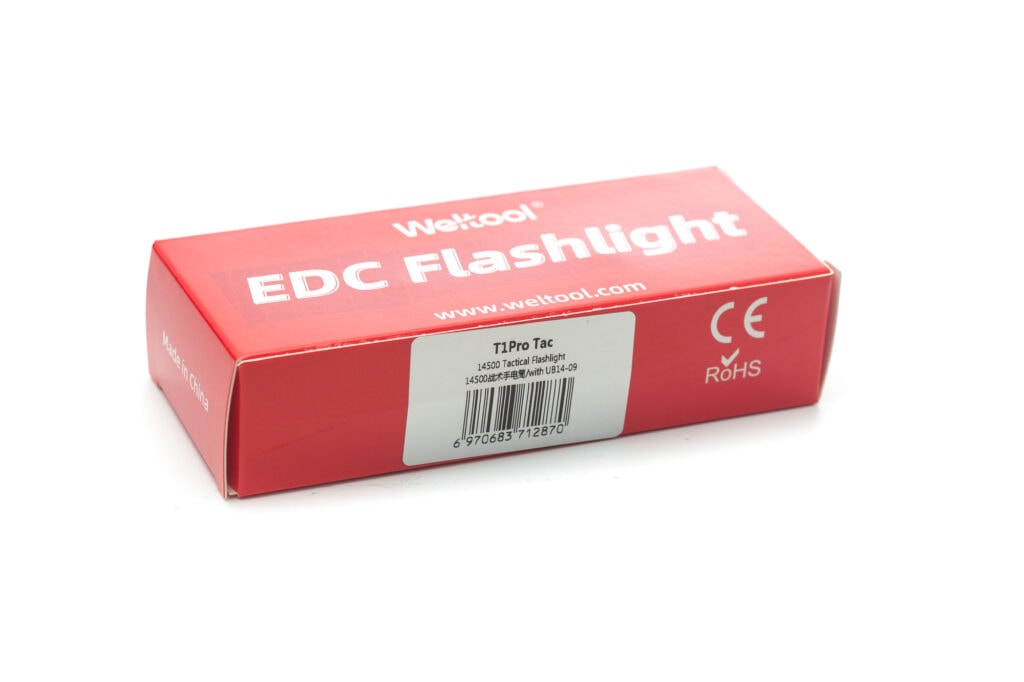
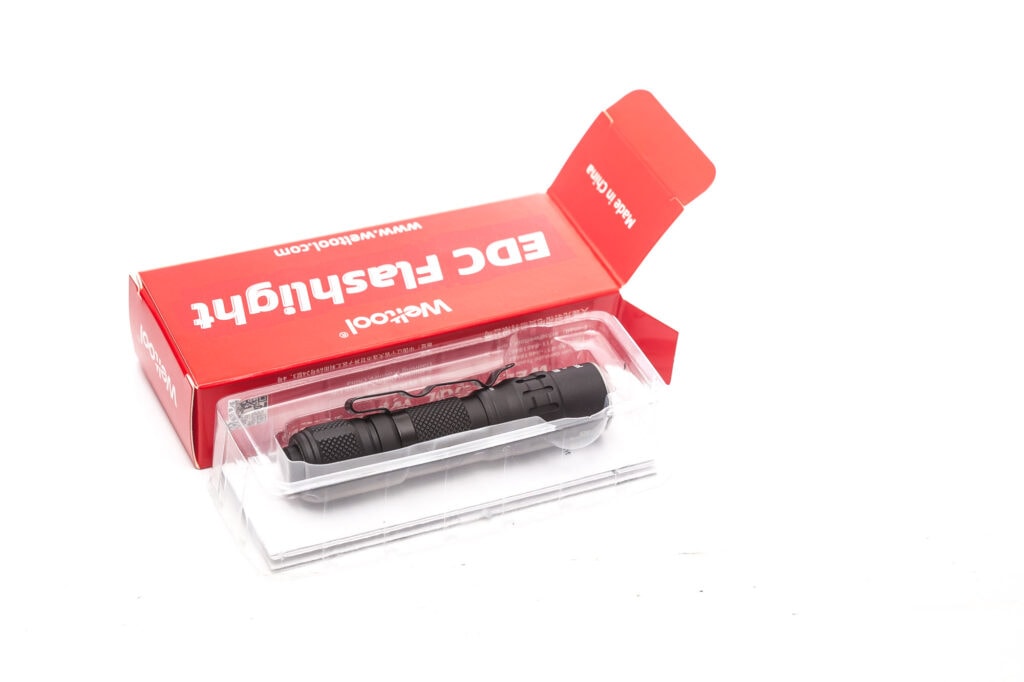
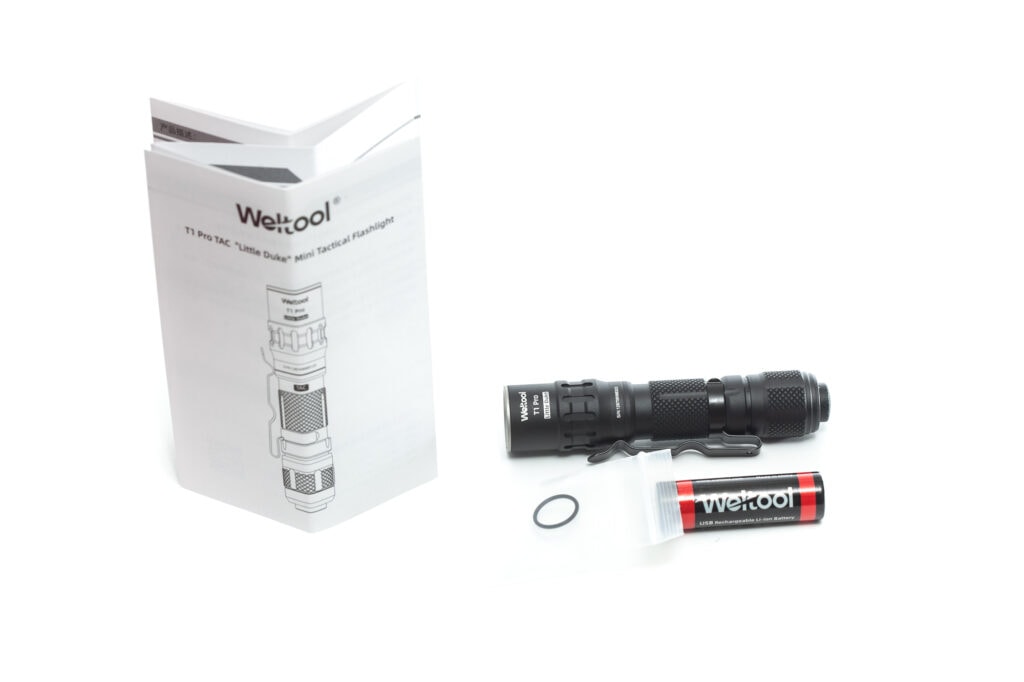
Flashlight in use, Build Quality, and Warranty
The little Weltool T1 Pro Tac is built very well for such a small flashlight, but that was to be expected from Weltool. All my Weltool flashlights are built great, and I never really had any real issues.
The T1 Pro Tac is powered by a single 14500 battery, making its body slim and short. It fits perfectly with normal AA-sized EDC flashlights.
Regarding handling, the T1 Pro Tac looks and feels like any small tactical flashlight with a rear forward-clicky switch. A forward clicky switch turns the flashlight momentarily on with a half press. If you do a full click, the flashlight will stay on continuously.
The flashlight can be used with the included 950mAh 14500, as well as AA batteries. There is even an extension tube available to use it with 2 AA batteries, which is labeled Weltool BB7.
Because of its size, it can easily be carried in your pocket, or you can use the pocket clip to give you a bit quicker access to it. The pocket clip can be removed, but it will also remove the possibility of carrying it with a lanyard because it attaches to the clip. It is also reversible, since the body has 2 slots for the clip. For that reason, you can clip it upward or downward.. which is pretty neat!
The tailcap is the only removable part of the flashlight. The body is glued to the head, and the stainless steel bezel also doesn’t budge, but is probably removable.
Weltool’s warranty, according to their website:
From the date of sale (the serial number on the Lights body can show the date), the limited warranty for LED products is 5 years, and the warranty for LEP products is 2 years.
The above free warranty does not cover any damages or failure caused by:
- Problems caused by alteration, misuse, abuse, or unreasonable
- Battery leakage , improper operation or using poor quality battery
- The products do not purchase from Weltool directly or its authorized dealers or other illegal way
- Broken lens caused by external force
- Lamp, switch runs out of its lifespan
- rubber cap, O ring’s naturally aging
- normal wear and tea, imprinting, or color finishes
- Other problems caused by improper operation
- Discontinued products
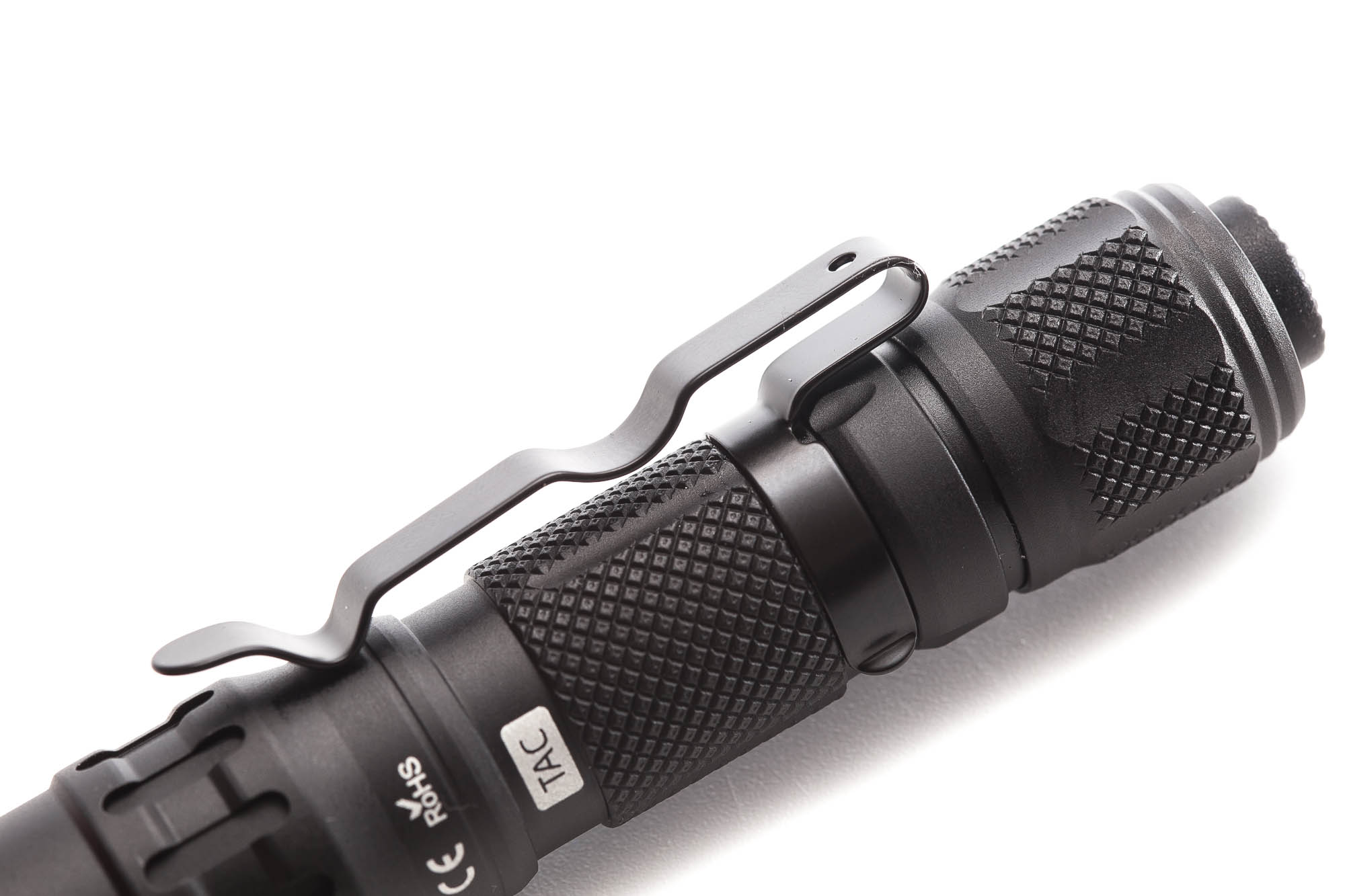
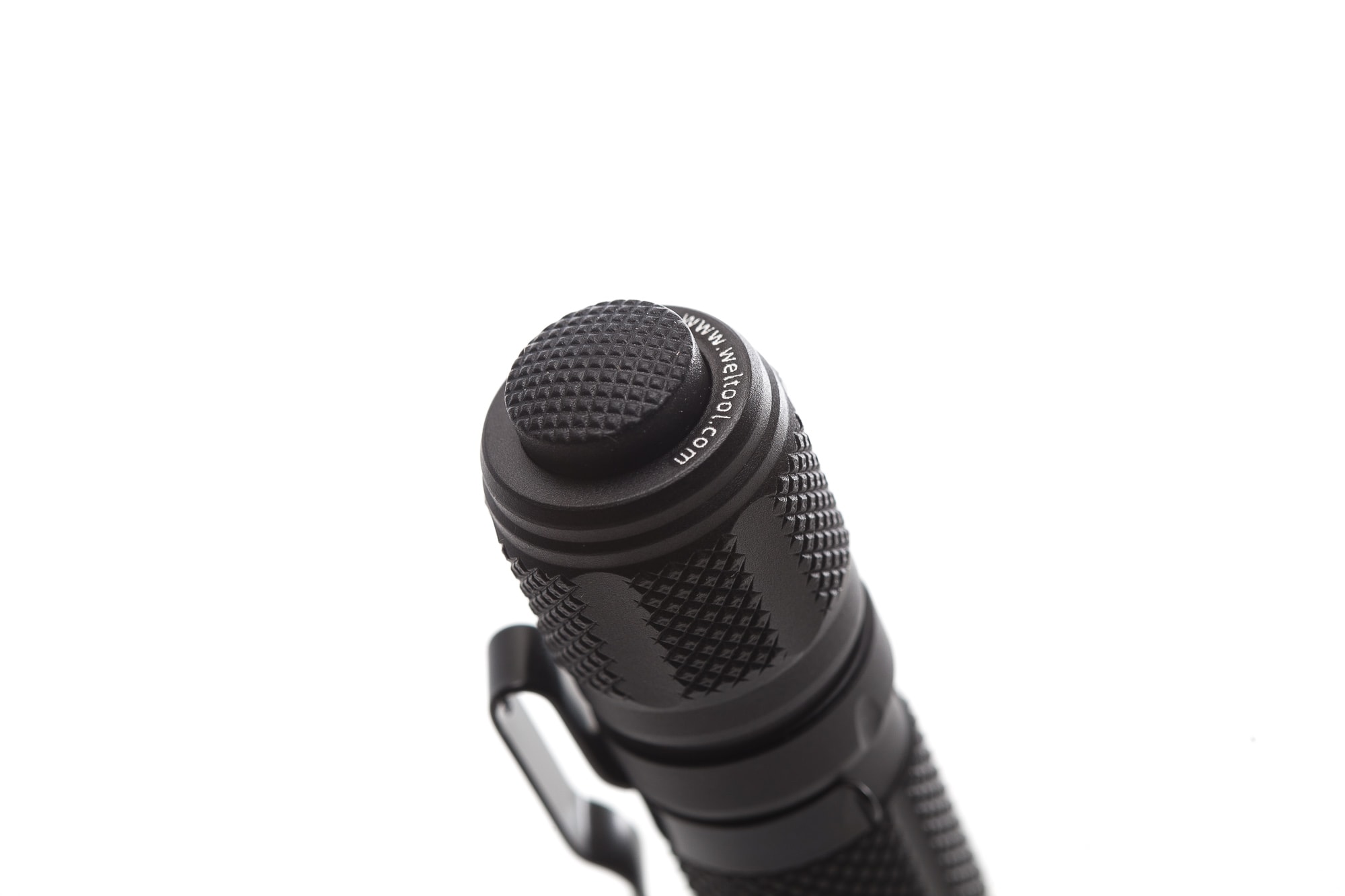
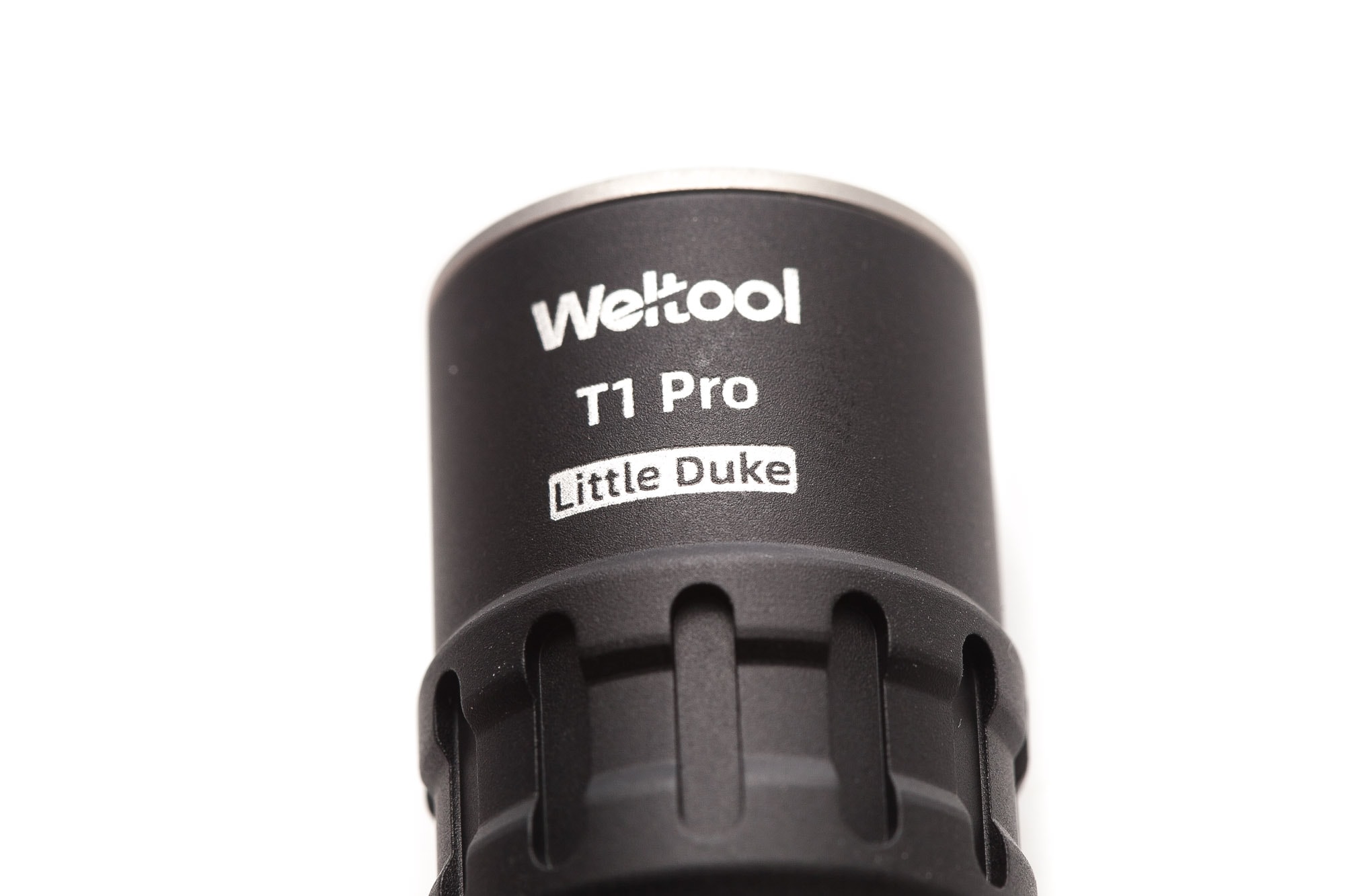
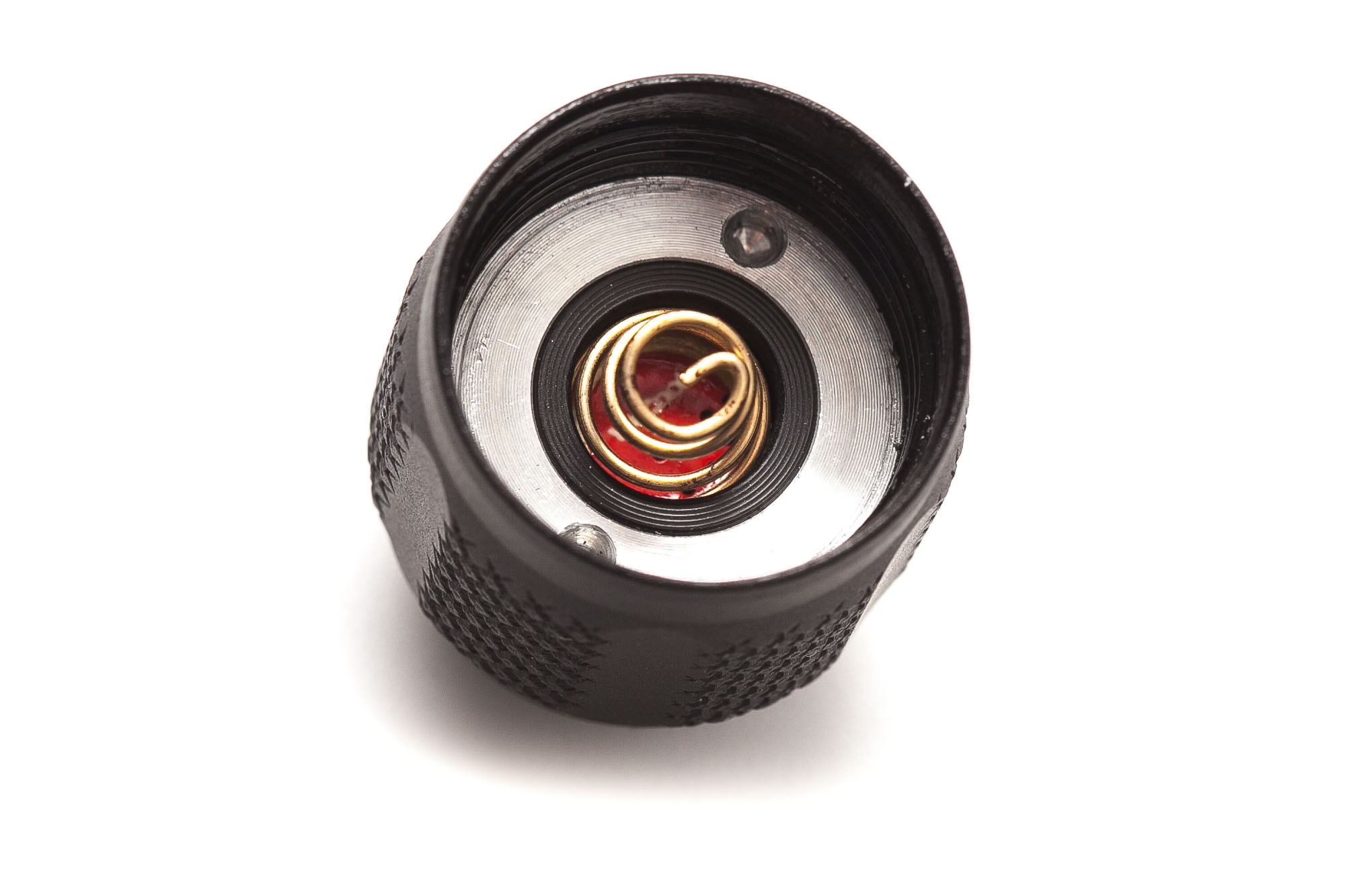
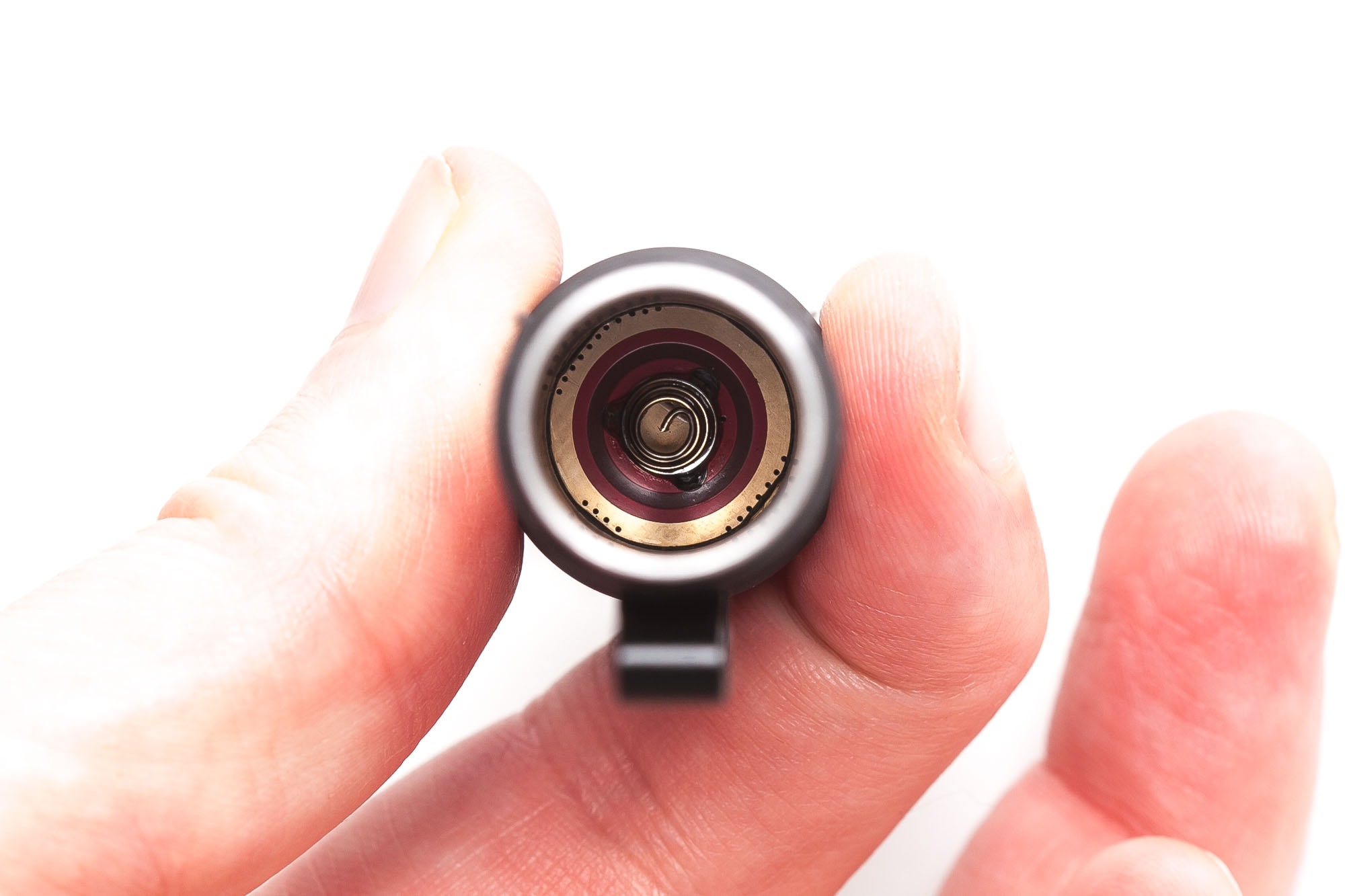
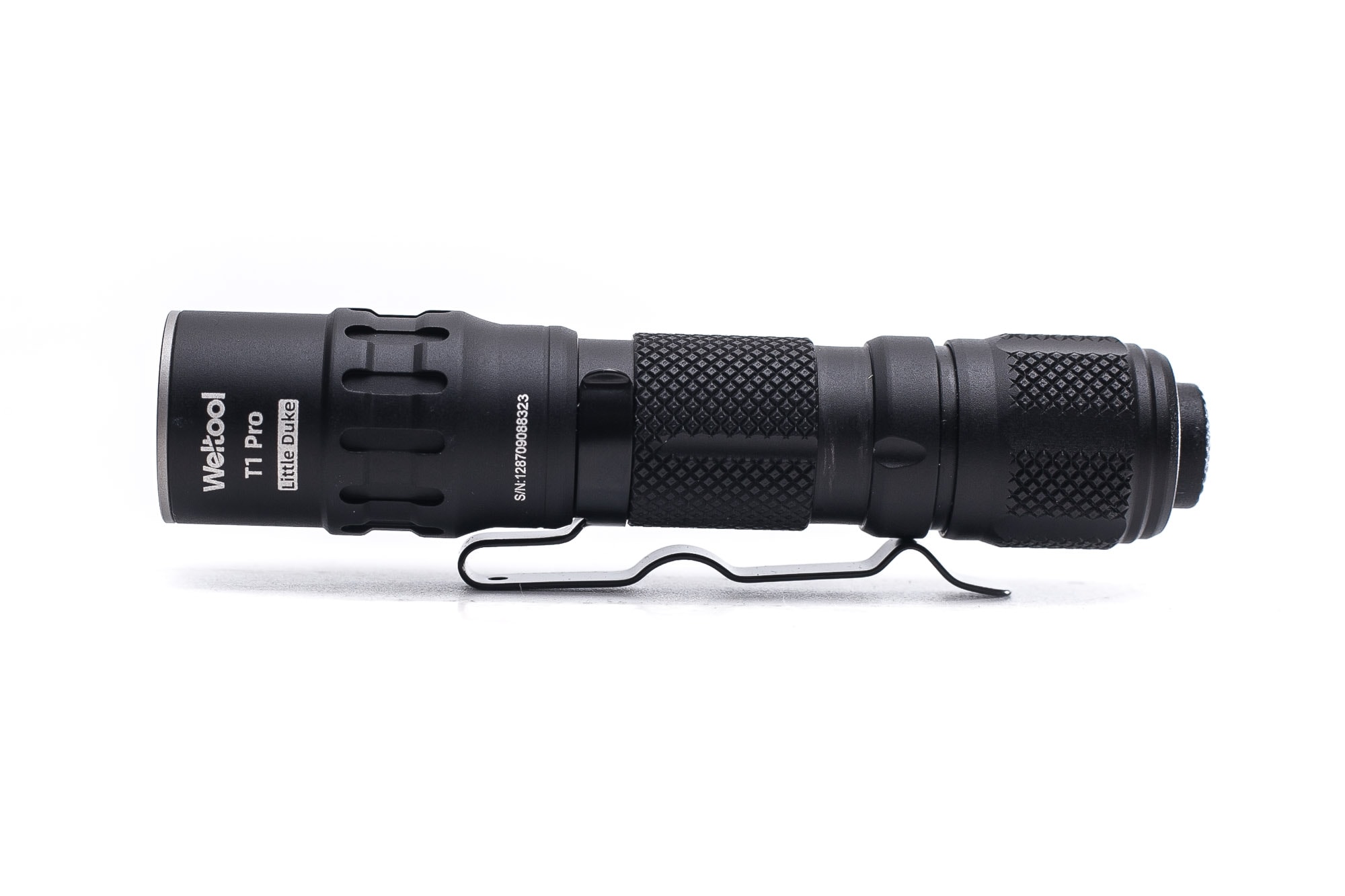
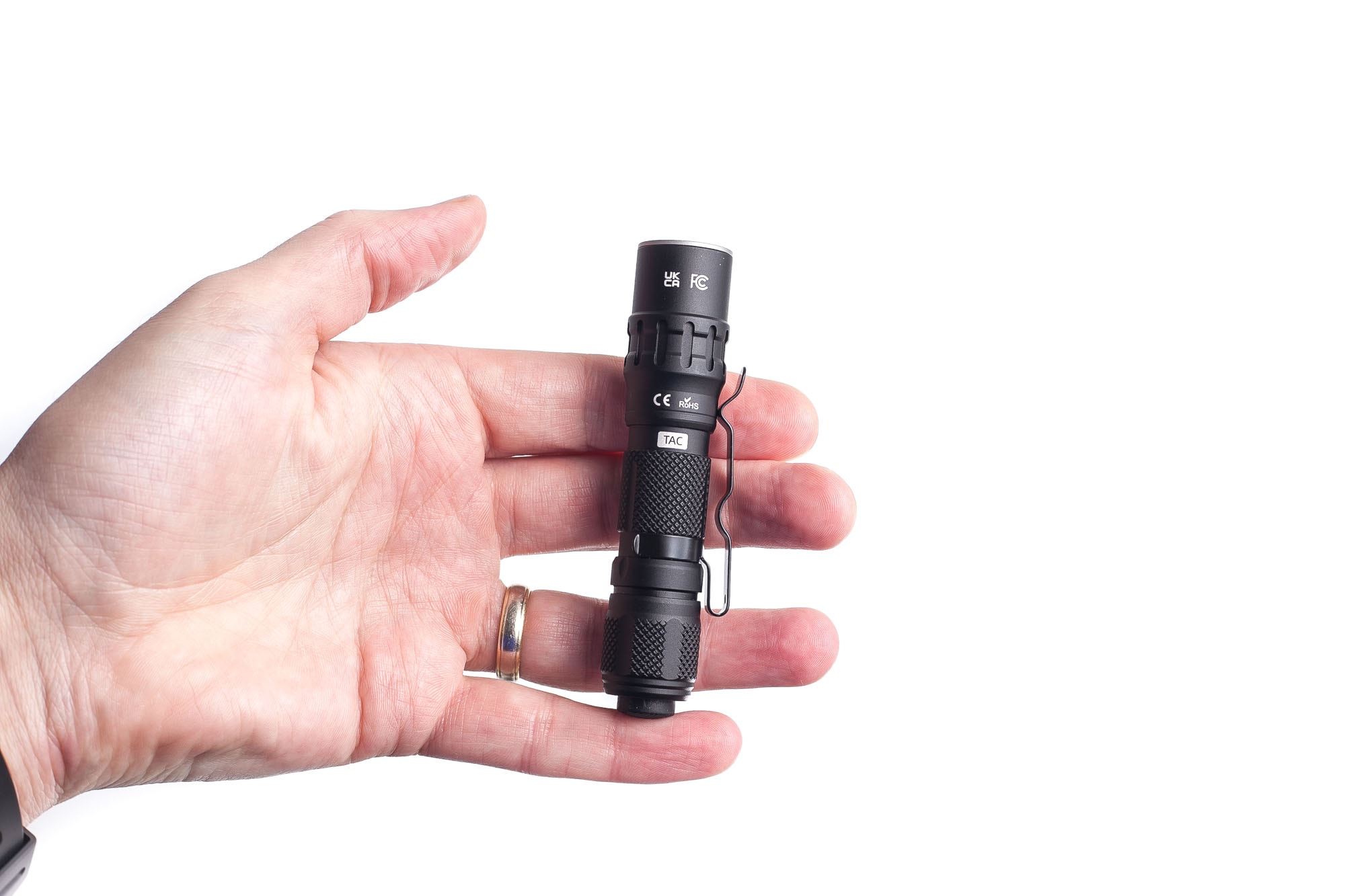
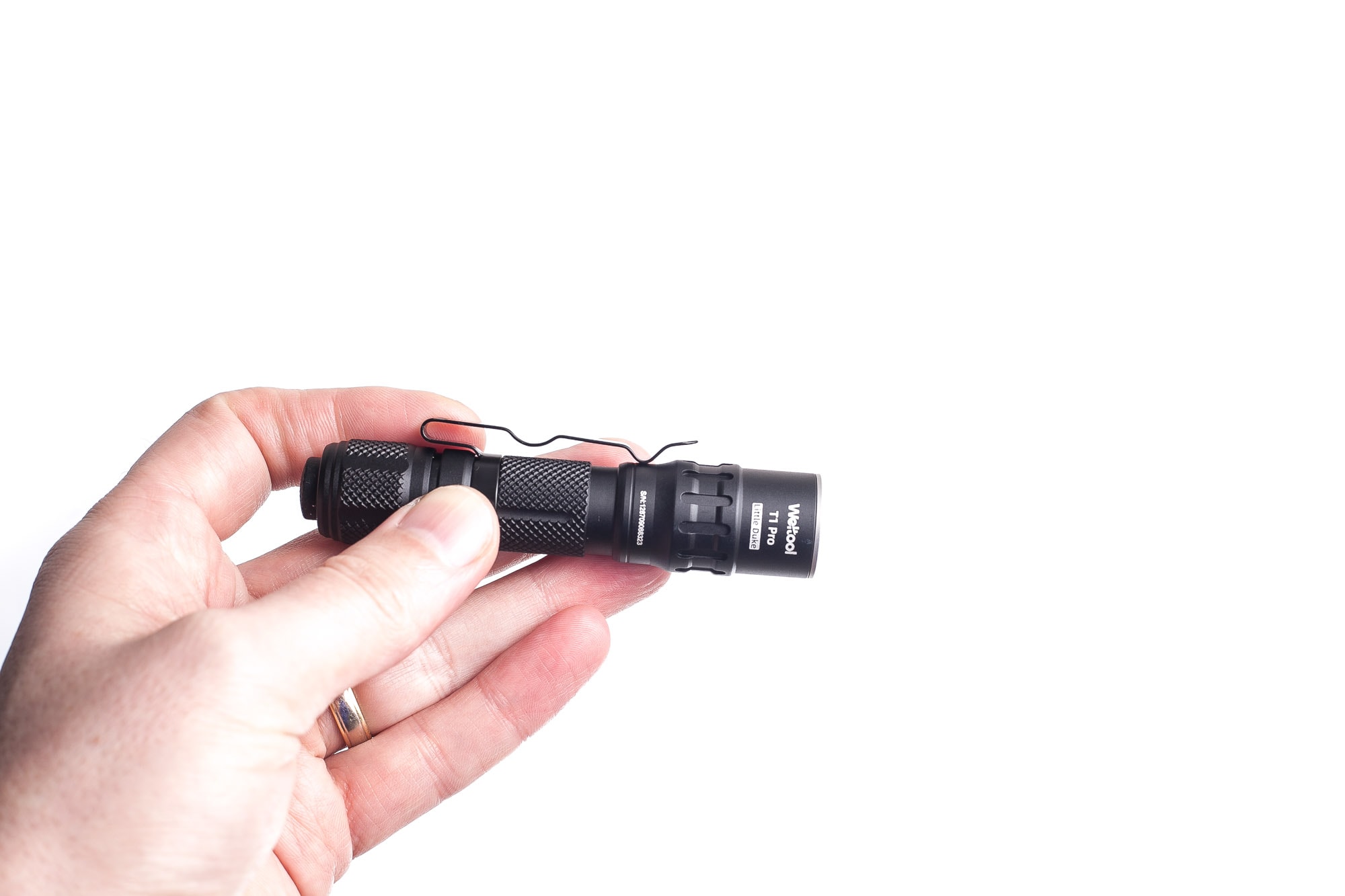
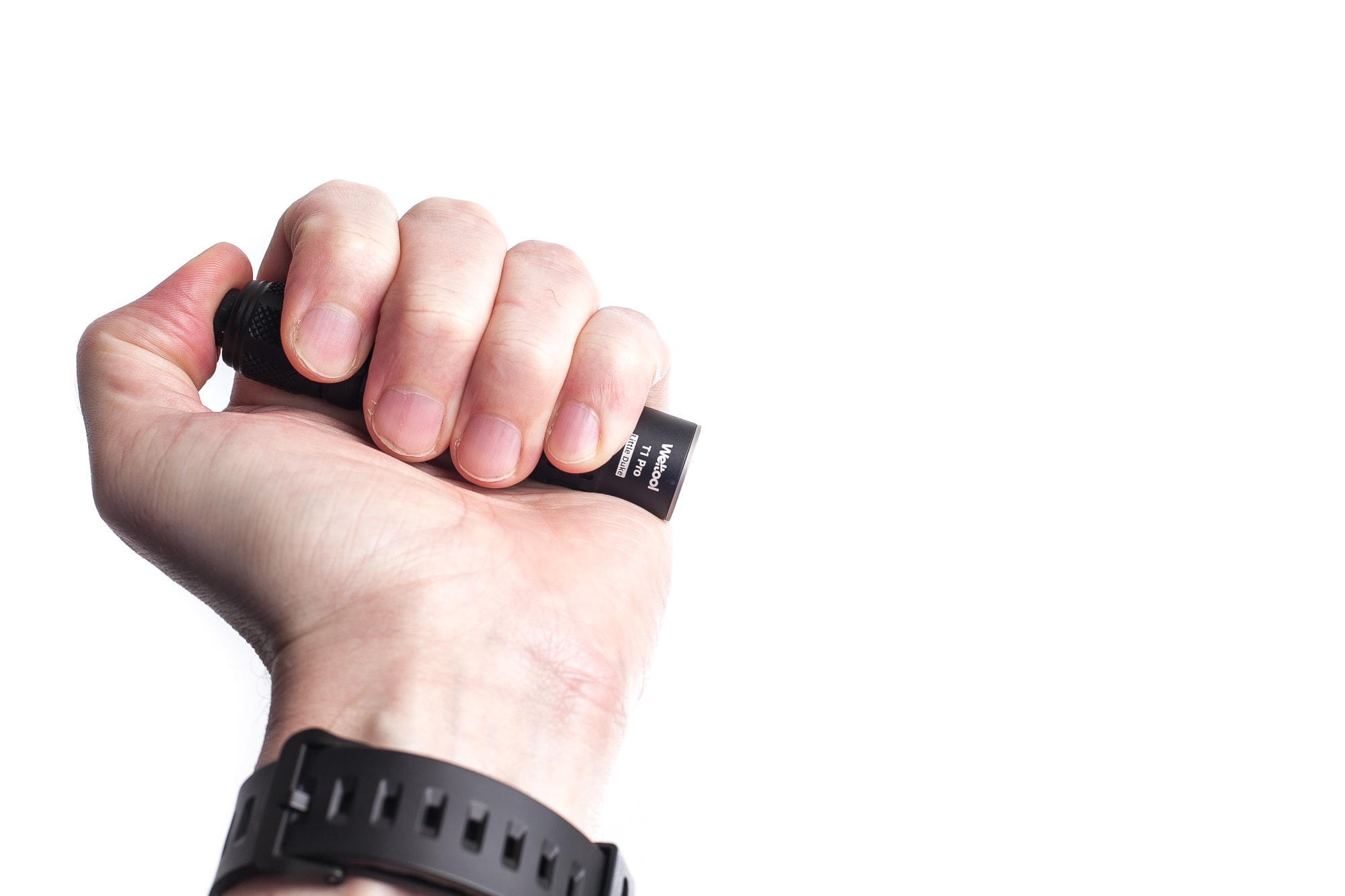
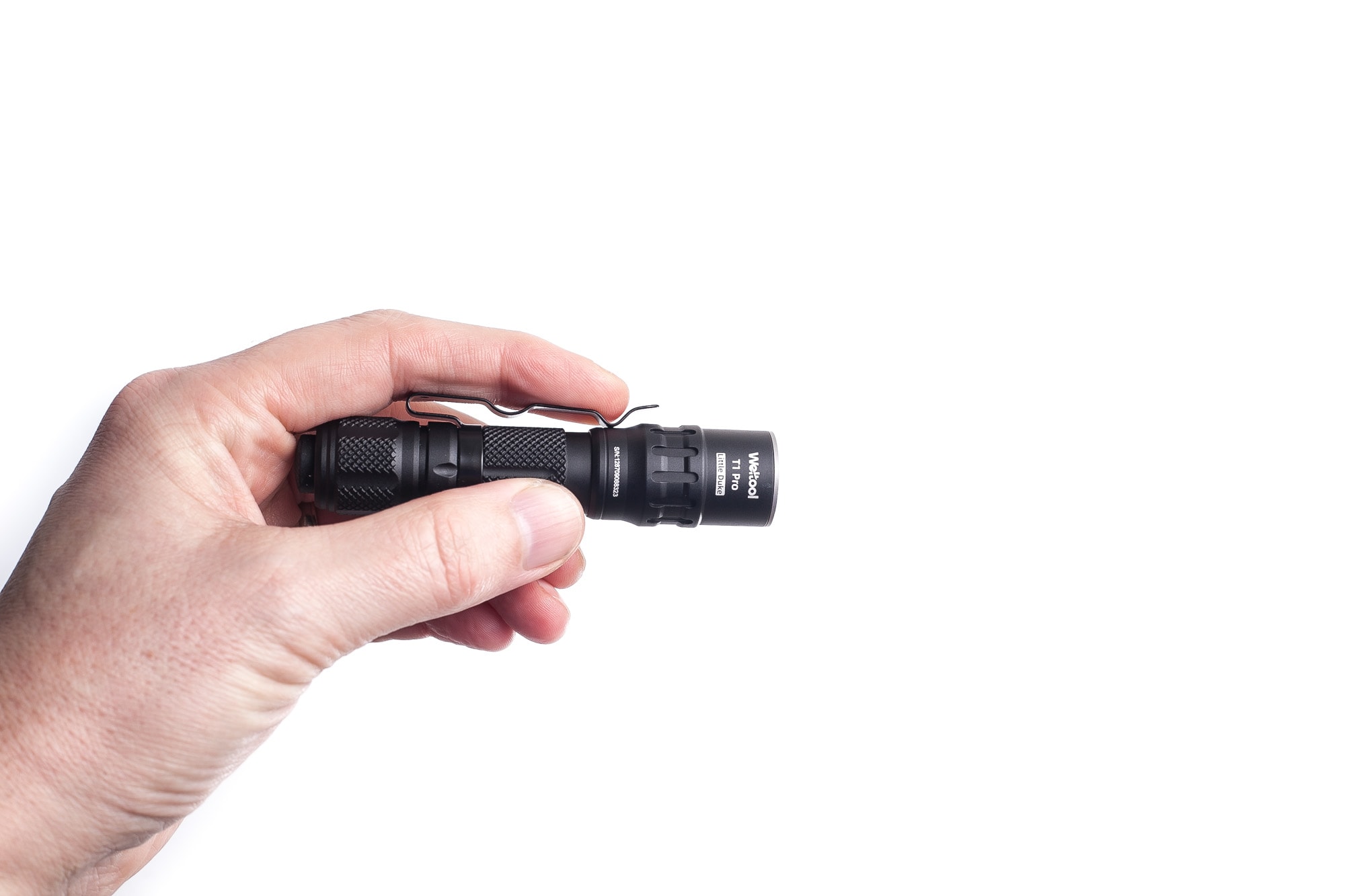
LED, Lens, Bezel, Beam, and Reflector
Now we are getting to the heart of the matter. Well, at least the heart of the flashlight, namely the LED. And according to the specifications it’s a 5000K High Density X-LED.
But when you look at it, you might notice a relatively popular thrower LED, namely the Osram W1.. I don’t know which version it is exactly, but I’m pretty sure it is an Osram W1.
The LED is centered well in a smooth reflector, and protected with a green AR coated lens. This is then protected by a stainless steel bezel, which is quite a bit tougher than aluminum. If you’d drop a flashlight with aluminum bezel, you’ll quickly deform it, but stainless steel is much stronger.
The beam itself is throwy, and at close distance, has a little of a flower petal pattern. And it’s pretty apparent to have a negative duv because it is pinkish. Could that be due to the green AR coated lens?
Anyway, time to do some of the first measurements.
Spectral measurements:
I used a Sekonic C800 spectrometer to measure the flashlight at 5 meters distance.
| Mode: | CCT: | CRI Ra: | duv |
|---|---|---|---|
| High | 5435 K | 67.7 | -0.0064 |
This means that the beam is neutral, with average low CRI, and a pinkish tint.
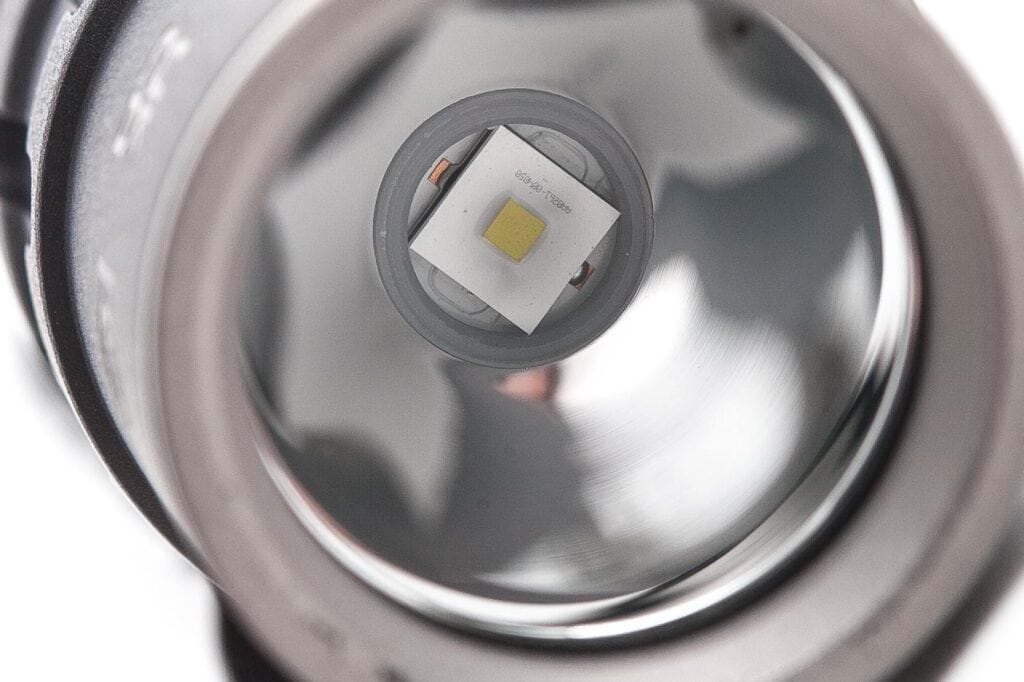
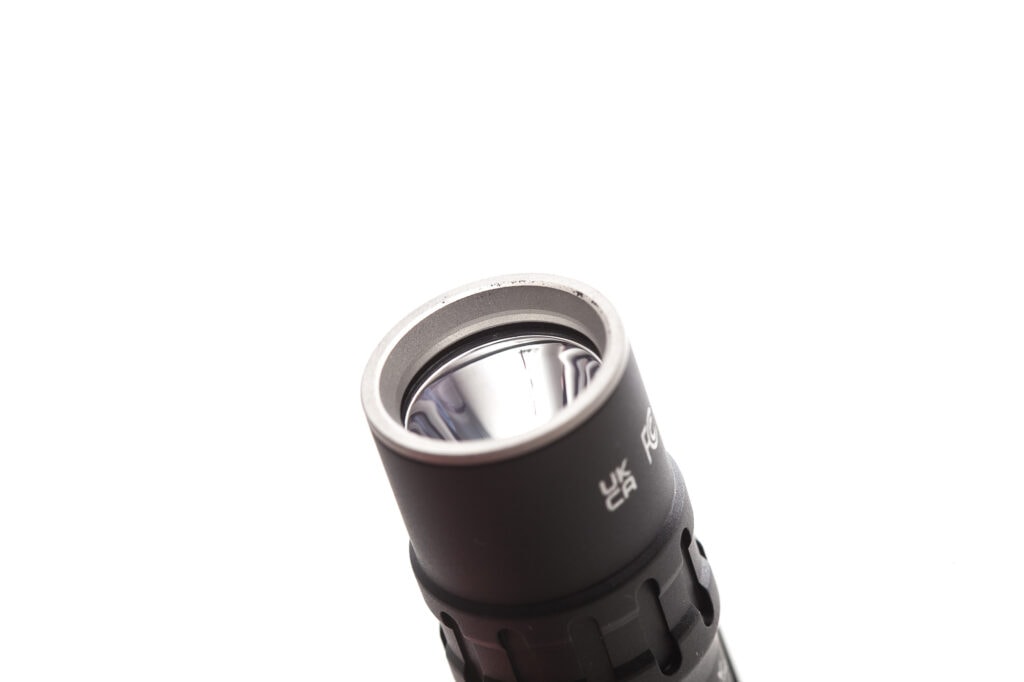
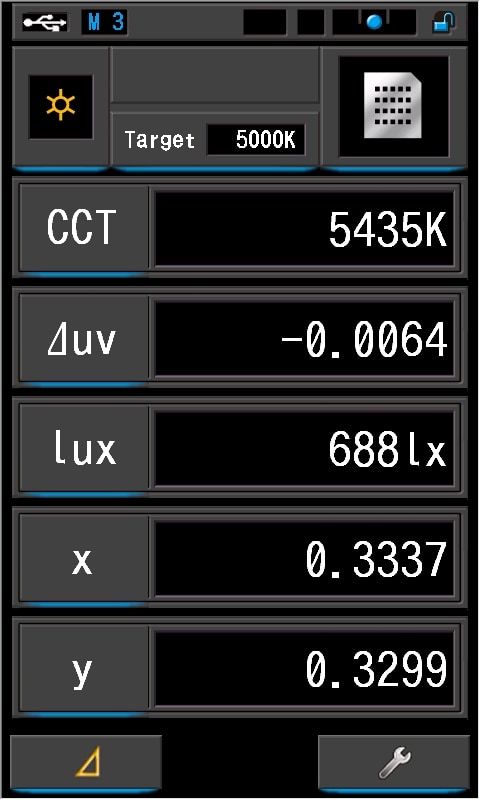
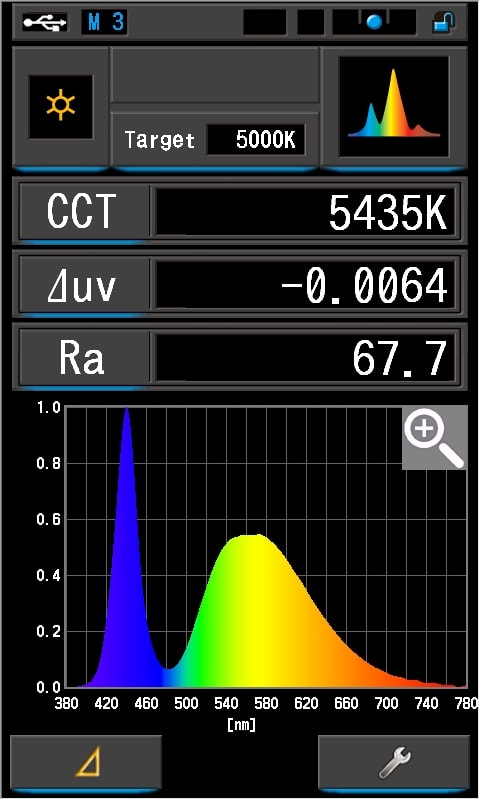
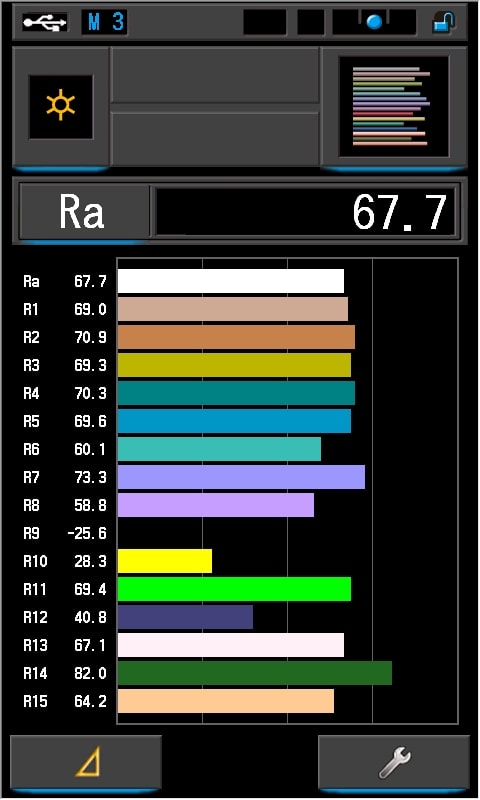
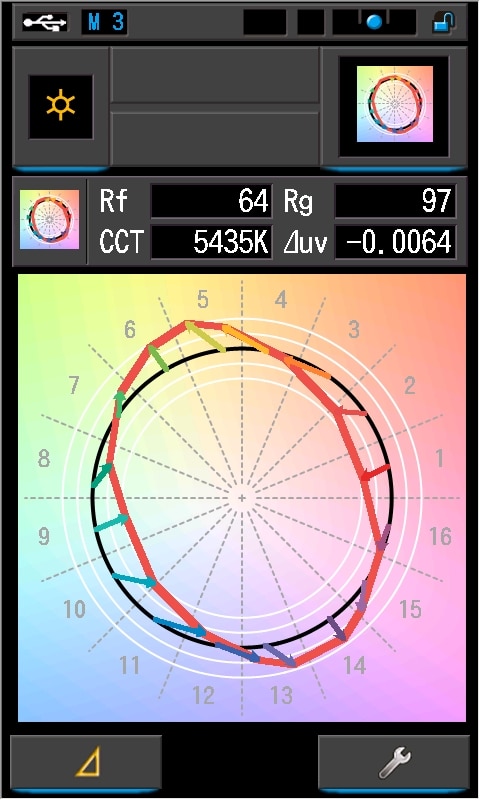
Dimensions and its competition
Dimensions:
| Weltool T1 Pro | Millimeters | Inches |
|---|---|---|
| Length | 98 mm | 3.9 in |
| Head diameter | 20 mm | 0.8 in |
| Tailcap diameter | 20 mm | 0.8 in |
| Body diameter | 18 mm | 0.7 in |
Dimensions are rounded to the nearest millimeter and the nearest tenth of an Inch.
Weight:
| Weltool T1 Pro | Weight in grams | Weight in oz. |
|---|---|---|
| Without battery: | 44.6 g | 1.6 oz |
| With battery | 64 g | 2.3 oz |
Weight is rounded to the nearest gram and tenth of an Oz.
Weltool T1 Pro Flashlight comparison
Group 1, from left to right: Weltool flashlights: Weltool T11, Weltool W3 Pro Tac, Weltool W3 Pro, Weltool T12, Weltool W2, Weltool T1 Pro
Group 2, from left to right: Olight i5R EOS, Acebeam Pokelit AA Gray, Lumintop Tool AA 2.0, Lumintop EDC01, Lumintop Ant Man, Weltool W2, Weltool T1 Pro Tac
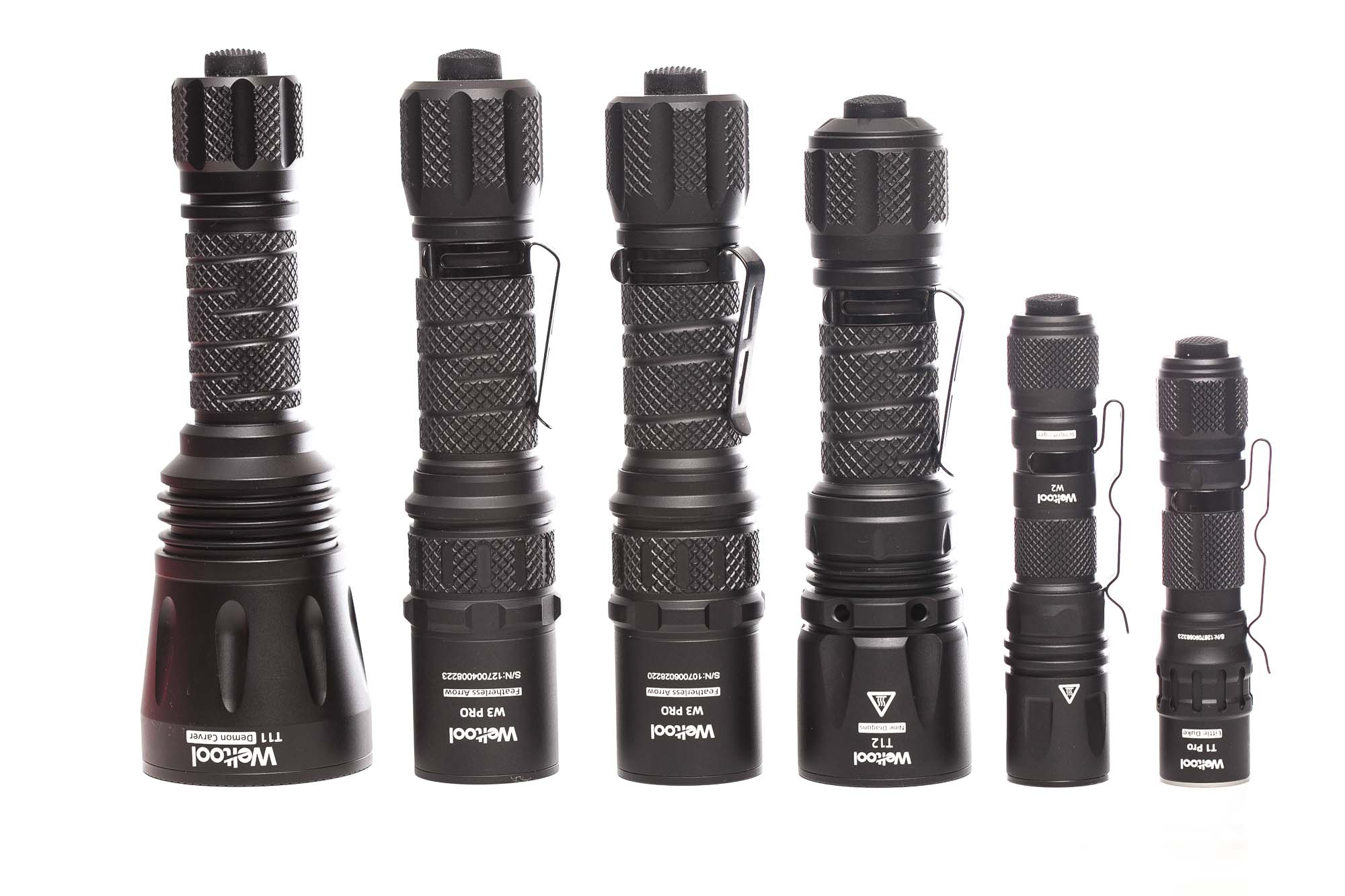
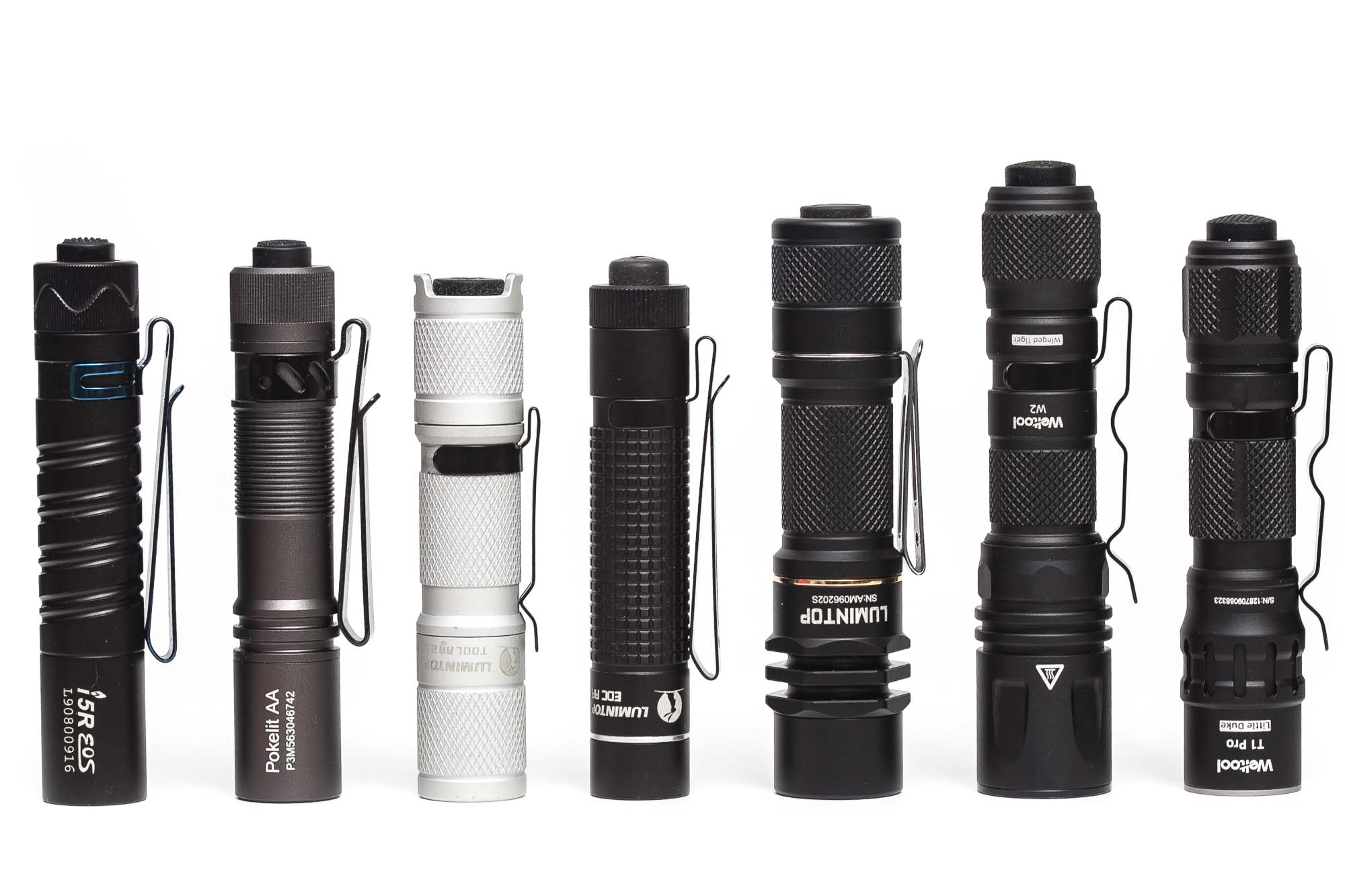
Weltool T1 Pro UI : User interface and driver
The UI is pretty straight forward with a forward clicky switch and only 2 modes, high and low.
The available main modes:
- Low, High
The available special modes (blinkies):
- N/A
How the UI works when the flashlight is still turned OFF:
- Half-press: High mode, momentary
- Single-click: High mode, continuous
- Quick 4-taps: Low mode, momentary
- Quick 4-taps + click: Low mode, continuous
How the UI works when the flashlight is turned ON:
- Single-click: turns off
Shortcuts within the UI:
- N/A. Always starts in High.. 4 taps for Low
Mode memory:
- There is basically only 1 mode, so no mode memory
Blinky modes:
- N/A
Low battery warning:
- N/A
Lock-out mode:
- None, just use the mechanical switch
PWM:
- Not that I can see by eye.
Firmware / UI Conclusion:
- It is basically a one-mode flashlight, but with a hidden low mode.. I quite like that. But as a tactical flashlight, I would have thought to include a strobe mode.
Weltool T1 Pro charging and batteries
Weltool added a Weltool UB14-09 battery into their package, a 14430-type lithium-ion battery with a 900mAh capacity. The size of this 14430 is about the same as an average 14500 battery, because of the built in USB-port. It arrived with a resting voltage of 3.87V.
The T1 Pro TAC facilitates 2 springs, so you can use flat top batteries, as well as button top batteries.
While charging the Weltool 14430, I used a USB tester and saw a charging Voltage of 5V and 0.475A charge current. A red light is visible when the battery is charging, and it turns off when it is finished.
A full charge took 2 hours and 22 minutes, and the end voltage was exactly 4.20V.
| Charge type | Fits | No fit | Charge time |
|---|---|---|---|
| Battery has USB-C | All 14430/14500/AA | – | 2 hours 22 minutes |
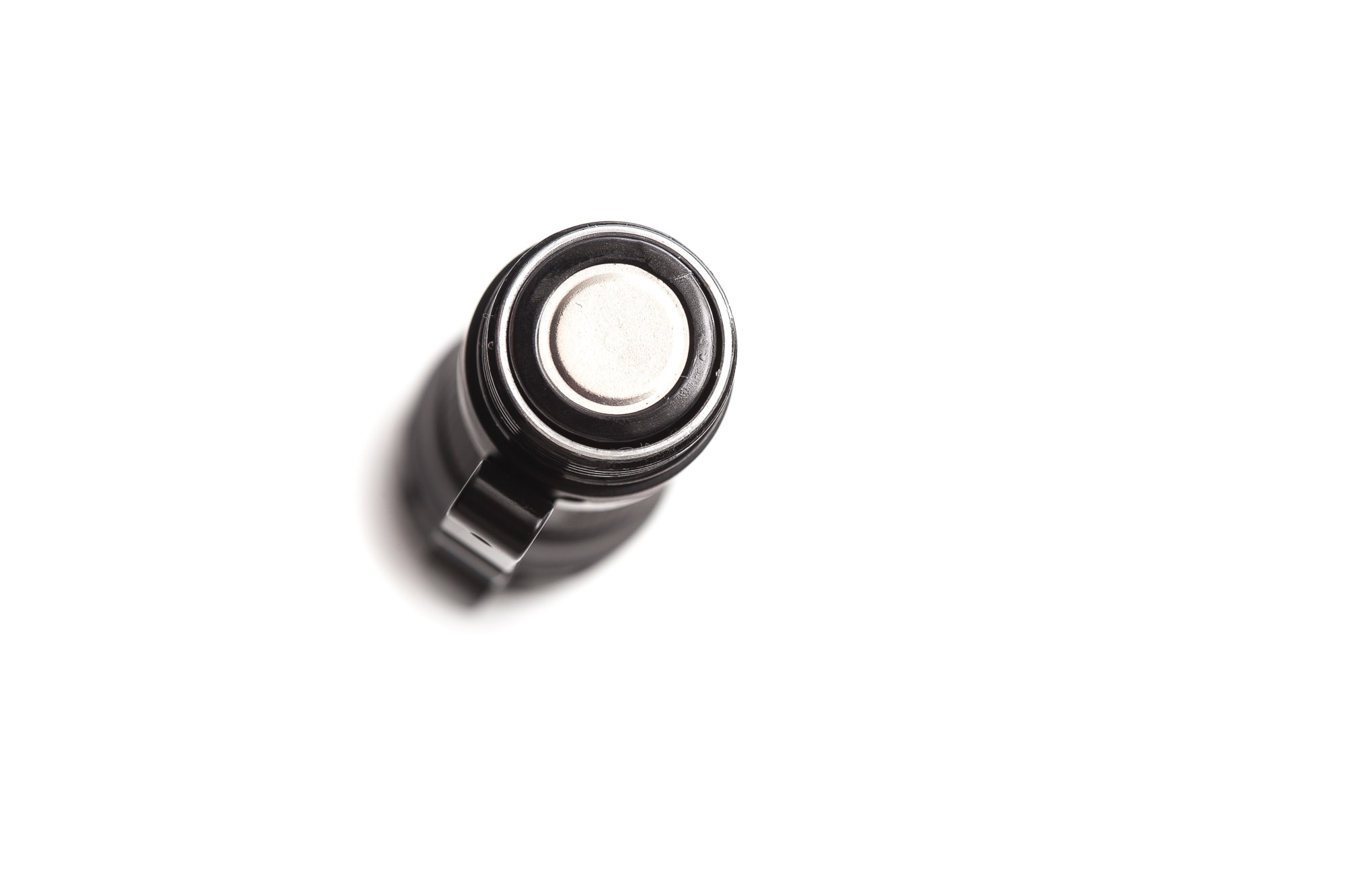
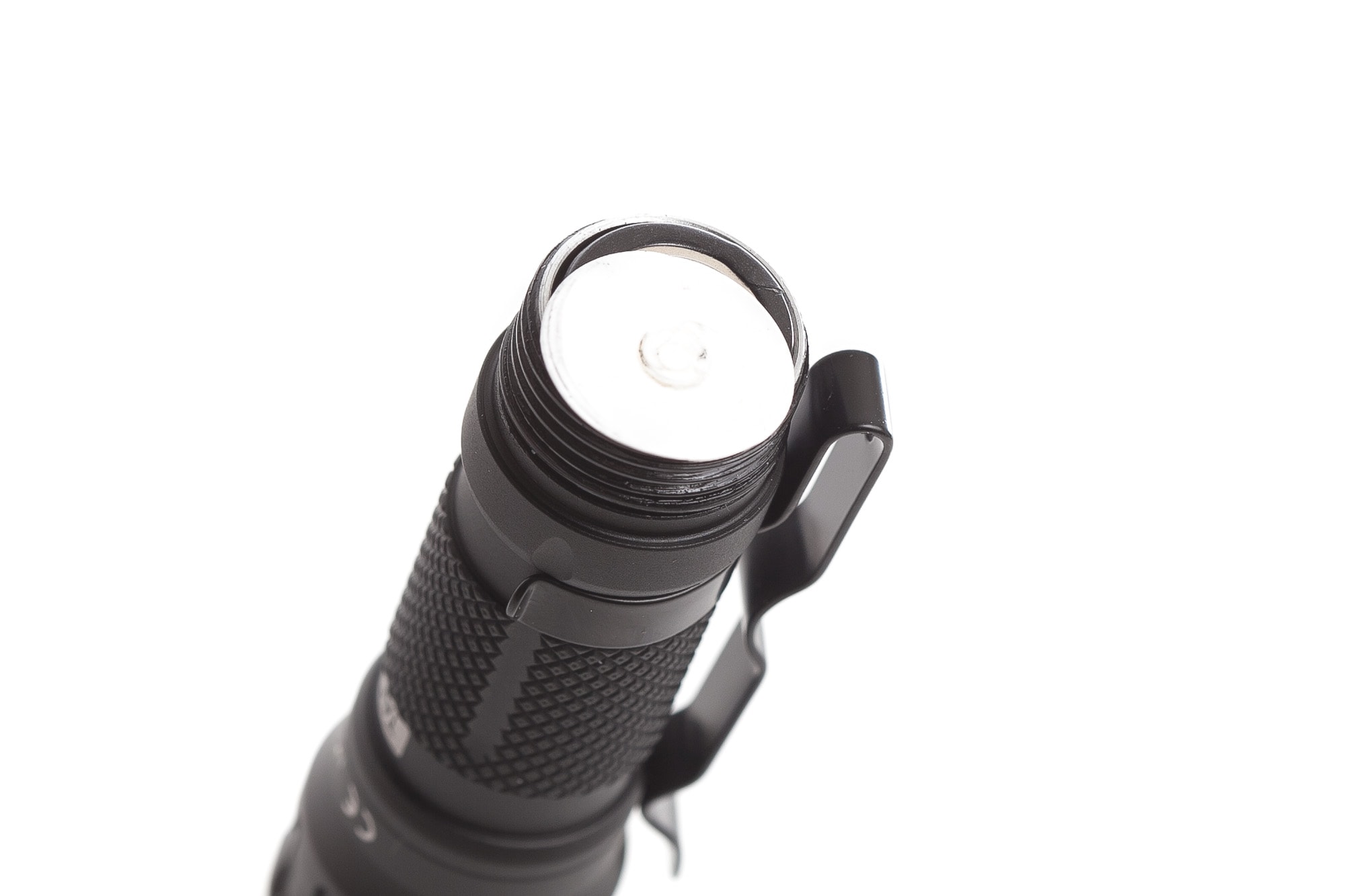
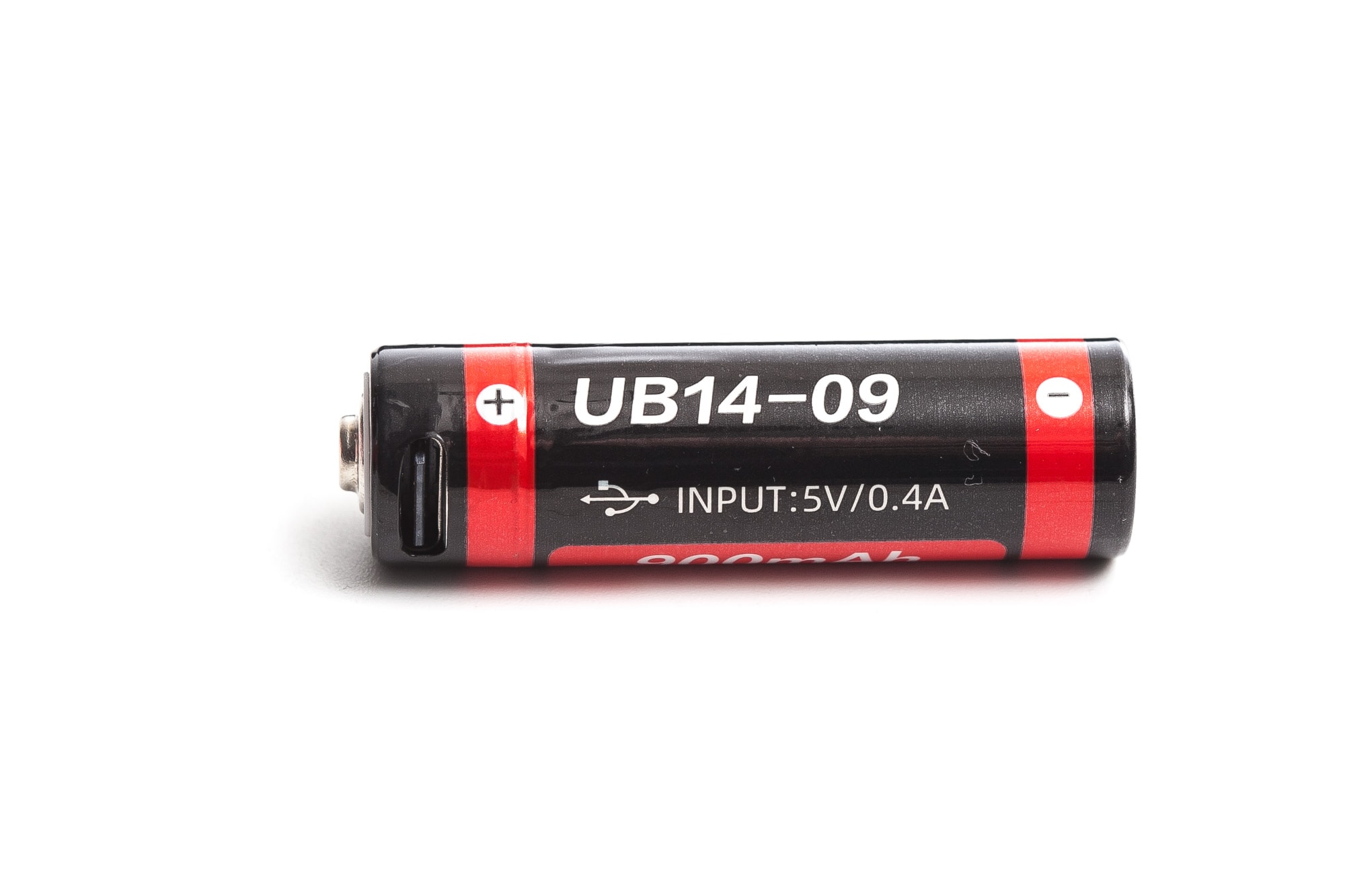
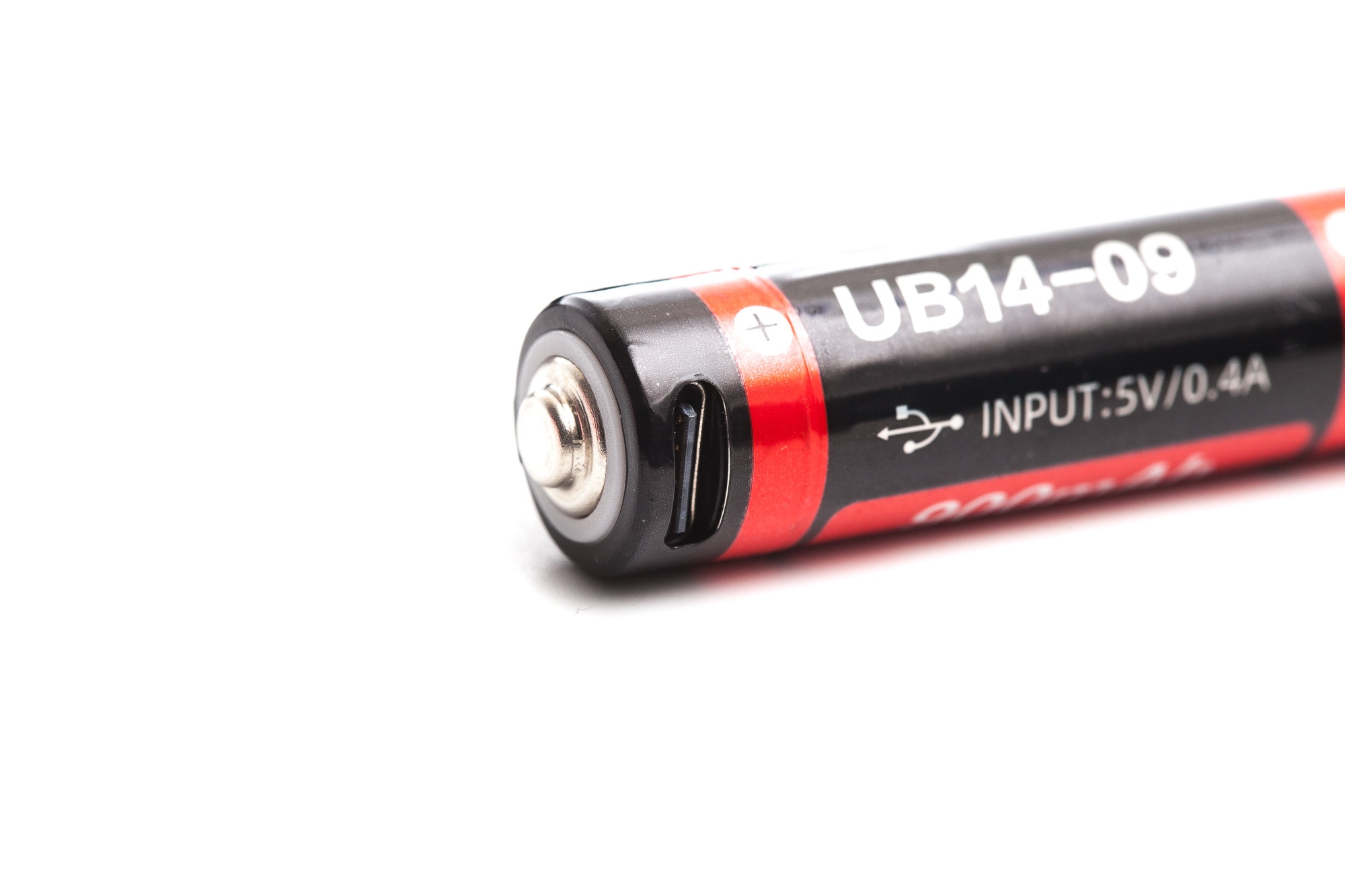
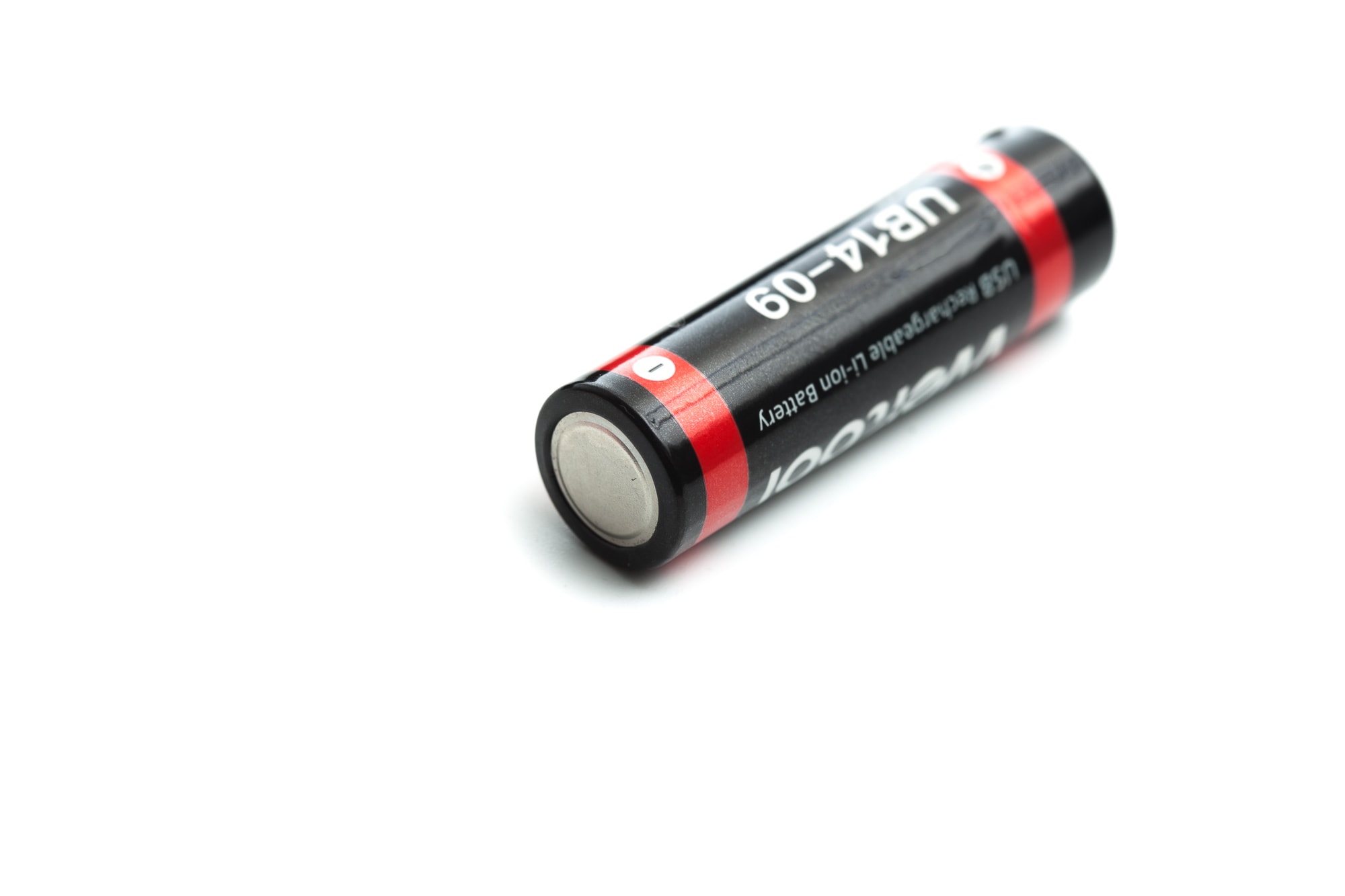
Performance test
This is the gear I use for testing:
| Gear | Purpose | Link to buy |
|---|---|---|
| Hagner E4-X | Measuring beam intensity (throw) | Inquire at Hagner.se |
| 2* Extech SDL400 | Lumens and logging runtimes | Amazon.com, Amazon.co.uk, |
| Leica Disto D2 | Distance for throw measurements | Amazon.com, Amazon.co.uk, |
| Sekonic C-800 | Spectrometer for LED measurements | Amazon.com, Amazon.co.uk |
| Uni-T UTi260B | Thermal Image camera | Amazon.com, |
Lumen measurements:
How Lumens are Measured: Understanding ANSI FL1 Standards How Lumens are Measured: Understanding ANSI FL1 Standards: The ANSI FL1 standards specify that output in lumens should be measured 30 seconds after turning on, as this is the standardized time for measuring brightness according to the industry standard. This is why we focus on this part in our measurements. The ANSI FL1 standards require an ambient temperature of 22 ± 3°C. We record the ambient the ambient temperature to identify potential reasons for any observed discrepancies.The output measurements in this review are based on my homemade integrating spheres, each equipped with an Extech SDL400 Lux Meter. For consistency and accuracy, a calibration light (Convoy S2+ with 249lm and a Convoy S2+ with 261lm) is measured before each set of lumen measurements.
One of the lux meters uses an ND camera filter for high-output lights to prevent the lux meter from maxing out. This is either the Kenko PRO1D ND16 for up to about 80,000 lumens or the Gobe ND32 for anything above.
All of my readings were taken from a fully-charged Weltool UR14-09, and Eneloop AA 2000mAh NiMH battery.
The measurements were taken manually at turn on and 30 seconds. The 10-minute numbers are taken from the runtime graph.
| Mode | Specified | turn on | 30sec | 10 min |
|---|---|---|---|---|
| Low (14430) | 86 lm | 64 lm | 64 lm | 62 lm |
| High (14430) | 540 lm | 447 lm | 416 lm | 352 lm |
| Low (AA NiMH) | 3 lm | 3.8 lm | 3.8 lm | 3.8 lm |
| High (AA NiMH) | 160 lm | 170 lm | 149 lm | 133 lm |
Ambient temperature during testing:
- 19.4 degrees Celsius (14430) and 20.8 degrees Celius (AA NiMH)
Weltool T1 Pro battery life and runtime
How Runtimes are Measured: Understanding ANSI FL1 Standards About ANSI FL1 runtime standards: The runtime is measured until the light drops to 10% of its initial output (30 seconds after turning on). This does not mean that the flashlight is not usable anymore. The last column shows how long the light actually works till it shuts off. If there is a + symbol, it means that the test was stopped at that particular point, but the light was actually still running. This happens on certain occasions, with certain drivers, firmware, or batteries.Runtime tests were conducted in my 50cm homemade integrating sphere, paired with the Extech SDL400 data logging Lux Meter. Temperatures from the moment the runtime test started.
| Mode | Specified | Runtime (ANSI FL1) | Time till shut off |
|---|---|---|---|
| Low 14430 (18.8°C) | 8h 42min | 7h 30min | 7h 30min |
| High 14430 (19.5°C) | 38min | 41 min | 41 min |
| Low AA Eneloop (20.5°C) | 92h | 39h 32min+ | 39h 32min+ |
| High AA Eneloop (18.2°C) | 39min | 1h 05min | 1h 14min+ |
After the runtime, the 14430 battery tripped, so it read 0V. The Eneloop AA battery measured 0.86V after High runtime, but it was still providing about 4 lumens of output. I aborted the Low runtime after 39 hours, when it was still measuring 1.27V.
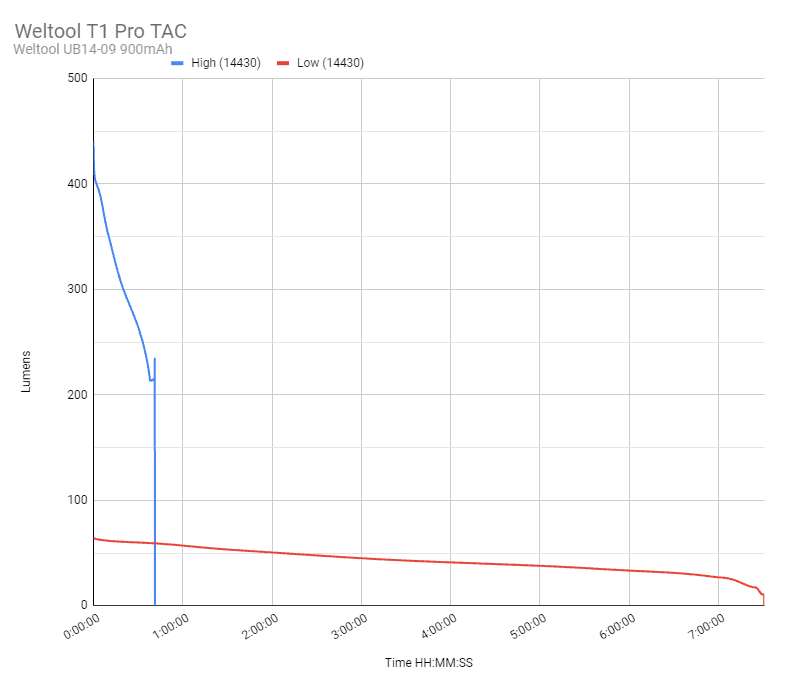
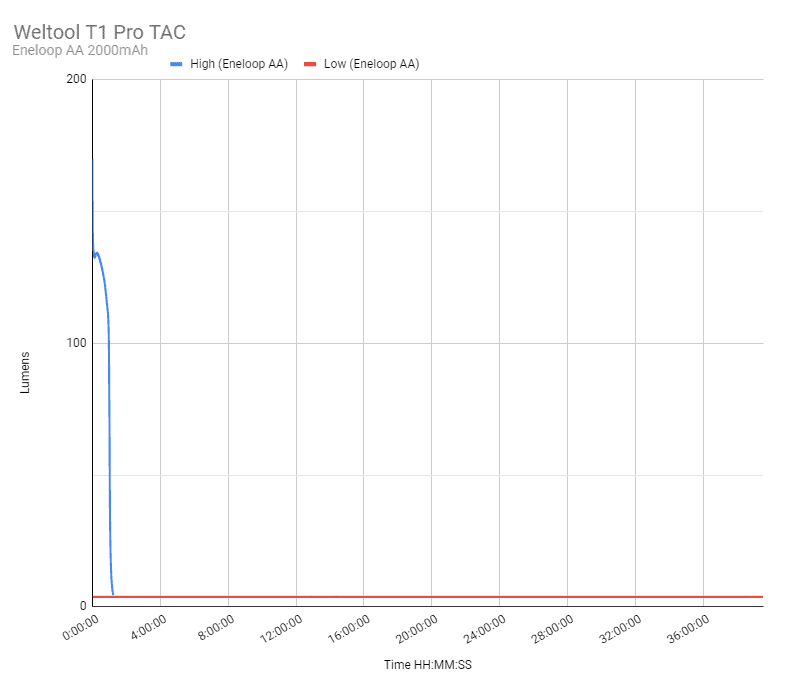
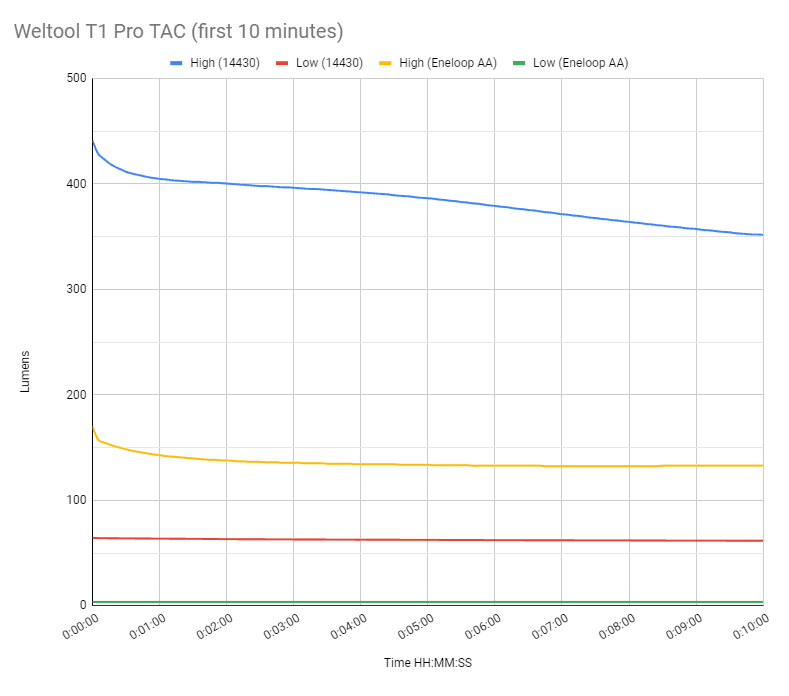
I have to say that the flashlight gets very hot during use with a 14500 battery.
Weltool T1 Pro Peak beam intensity and beam distance measurements
About Peak beam intensity: Understanding ANSI FL1 Standards About peak beam intensity The calculated value of distance in meters at which the flashlight produces a light intensity of 0.25 lux. (0.25 lux is about the brightness of a full moon shining on an object). This means that the intensity has decreased so much, it becomes difficult to see darker objects, or objects that don’t reflect light. The columns ‘Meters’ and ‘Yards’ use rounded numbers.Measurements were taken indoors at 5 meters with a Hagner E4-X Lux Meter. The measurements were taken 30 seconds after turn on. *I also tested it outdoors at 20 meters, in the cold, at around 0 degrees, but it measured almost 10% lower.
| Mode (battery) | Specified | I measured | meters | yards |
|---|---|---|---|---|
| High (14430) | 21,060 cd | 17,000 cd | 261 m | 285 yd |
| Low (14430) | 2,560 cd | 2,500 cd | 100 m | 109 yd |
| High (Eneloop AA) | 5,780 cd | 5,300 cd | 146 m | 159 yd |
| Low (Eneloop AA) | 148 cd | 150 cd | 24 m | 27 yd |
| *High (14430 20meters) | 21,060 cd | 15,600 cd | 250 m | 273 yd |
Ambient temperature during testing:
- Indoors: 18.8 degrees Celsius, outdoors 0 degrees Celsius*.
Beamshots
For the shed and reflective fence beamshots, I used a Canon EOS 5D Mk2 with a 50mm lens. Manual settings: ISO1600, 1/4sec, F4, 5000K. The shed is about 65 meters / 71 yards away, and the reflective fence is about 200 meters.
Explore and compare the beamshots from the following flashlights:
- Weltool T1 Pro
- Weltool W2
- Lumintop Ant Man
- Olight Diffuse
- Manker E05
Please note that the following beamshots are mainly intended to showcase the beam pattern and beam quality, rather than overall performance. These images are typically taken directly after activation, and in different seasons or weather conditions, and therefore do not fully represent its overall performance. For accurate performance metrics, such as output, beam distance, and runtimes, you need to look at the performance section of this review.
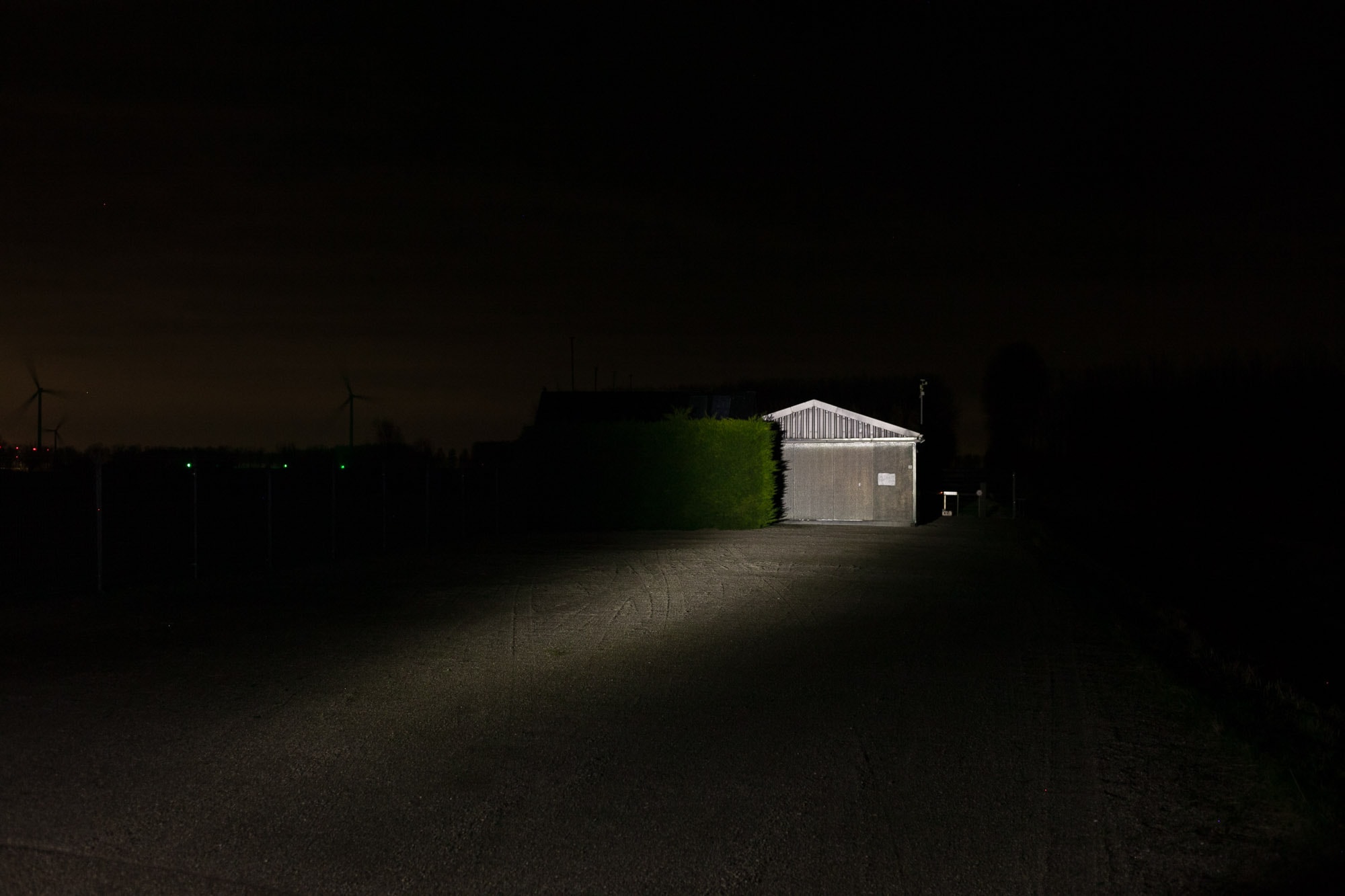
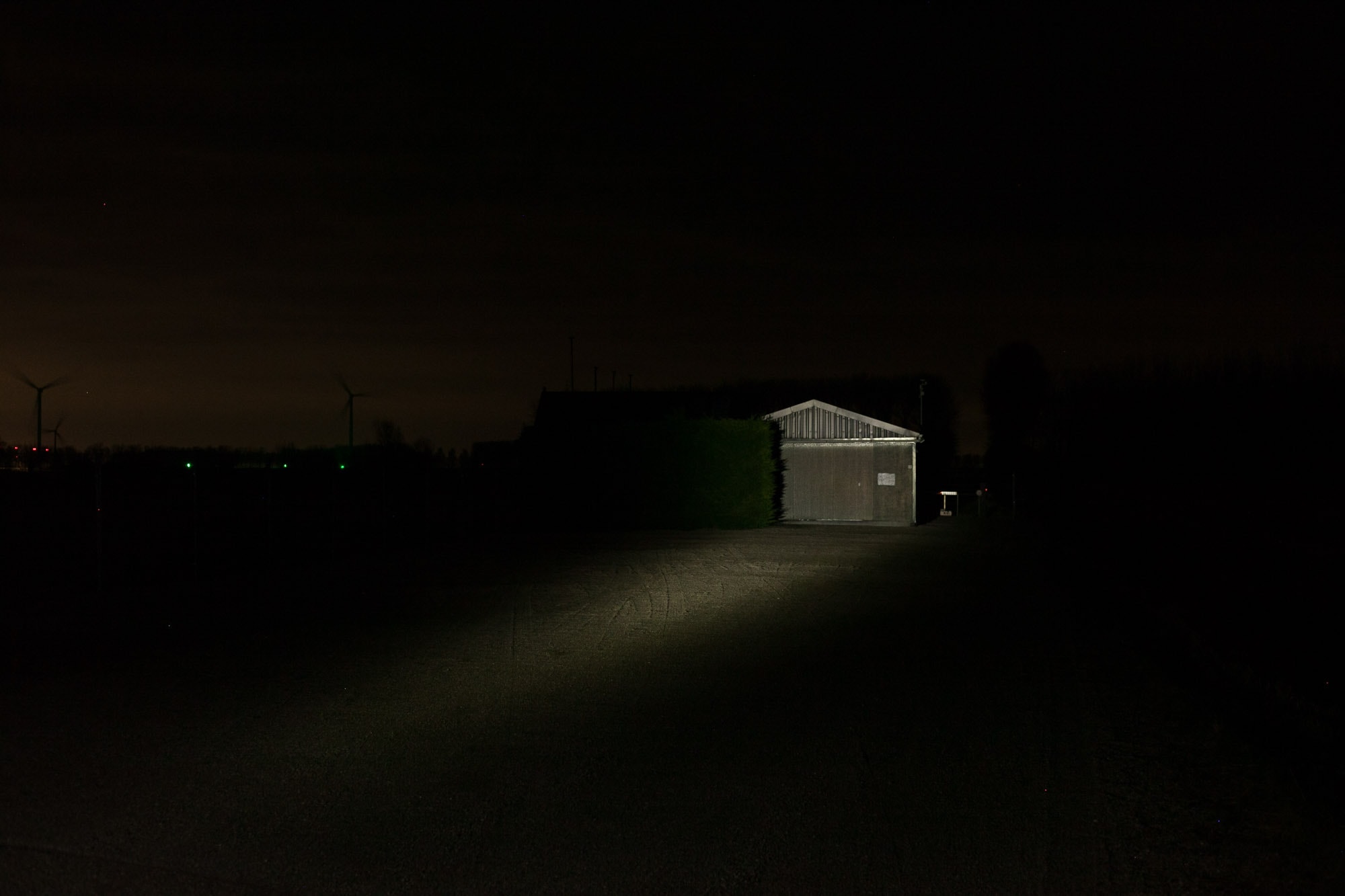
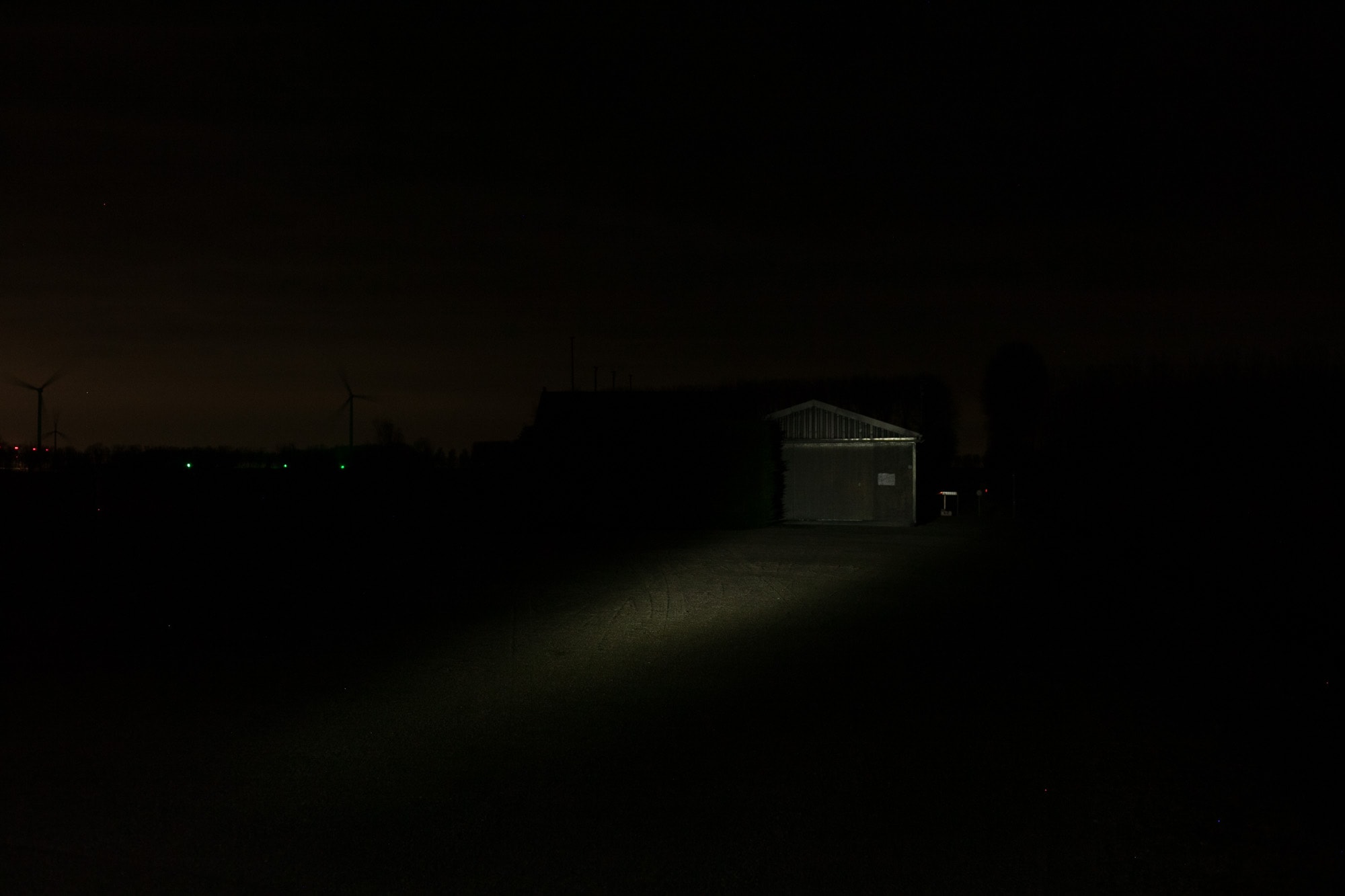
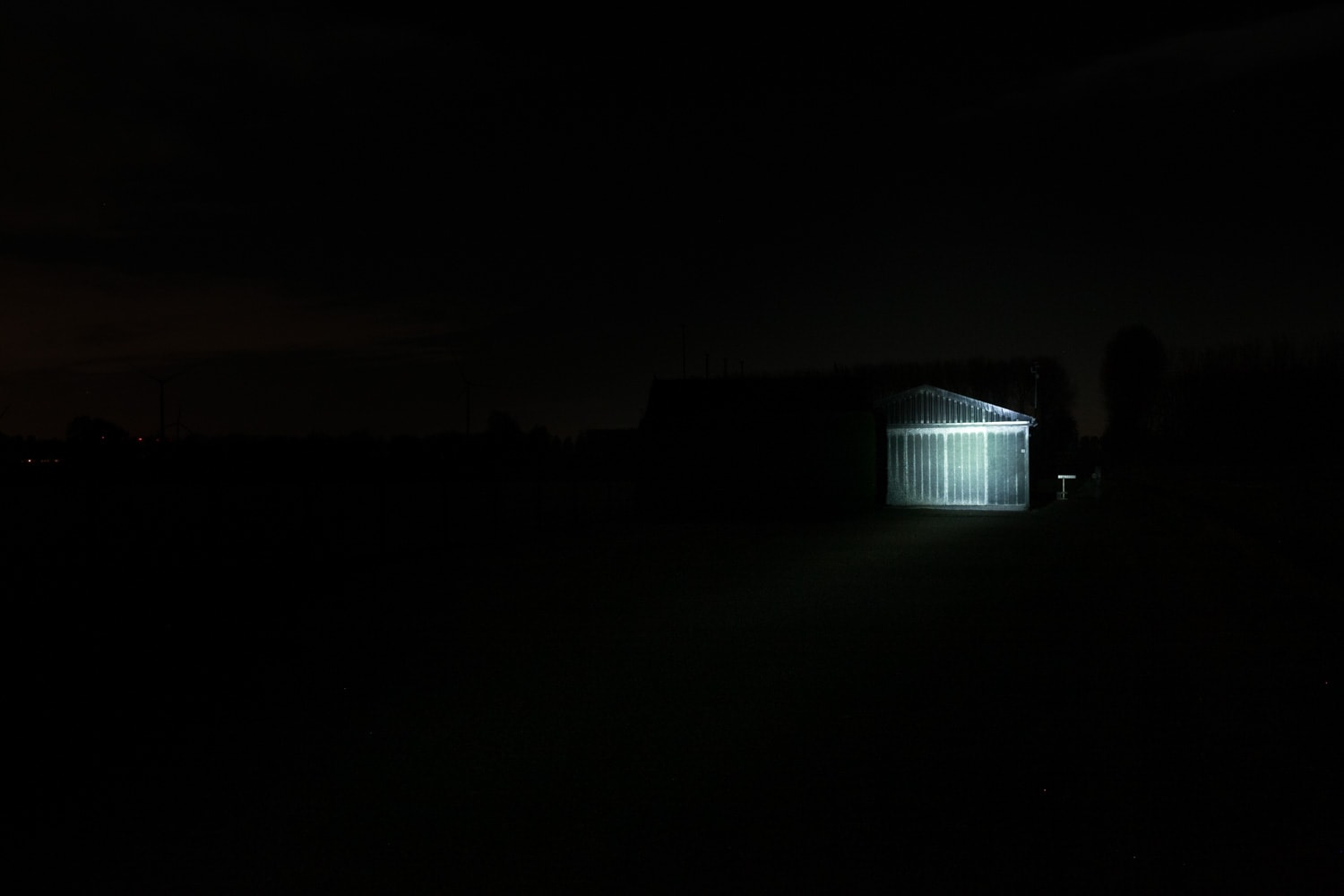
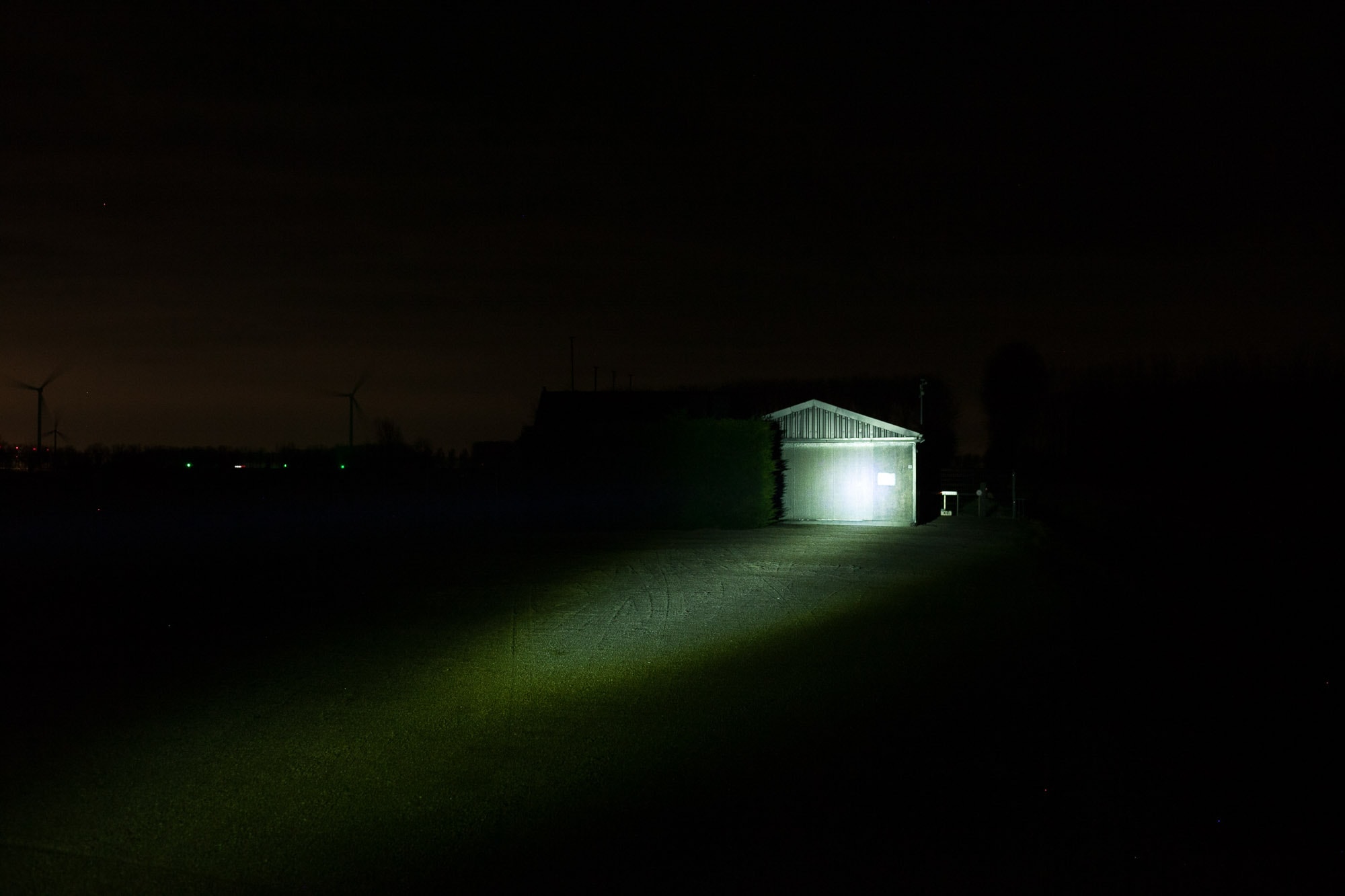
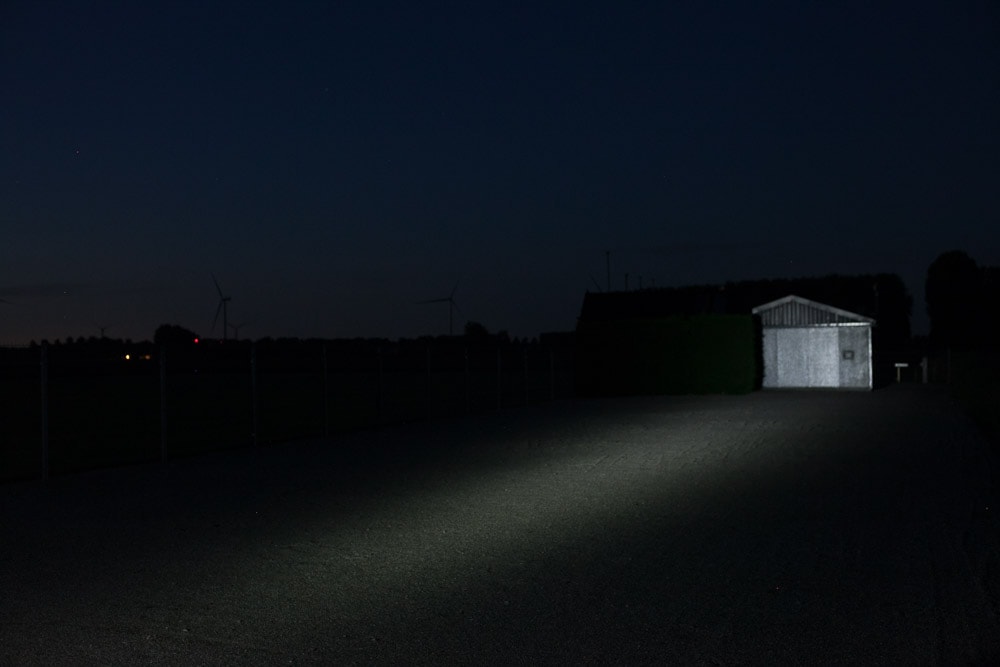
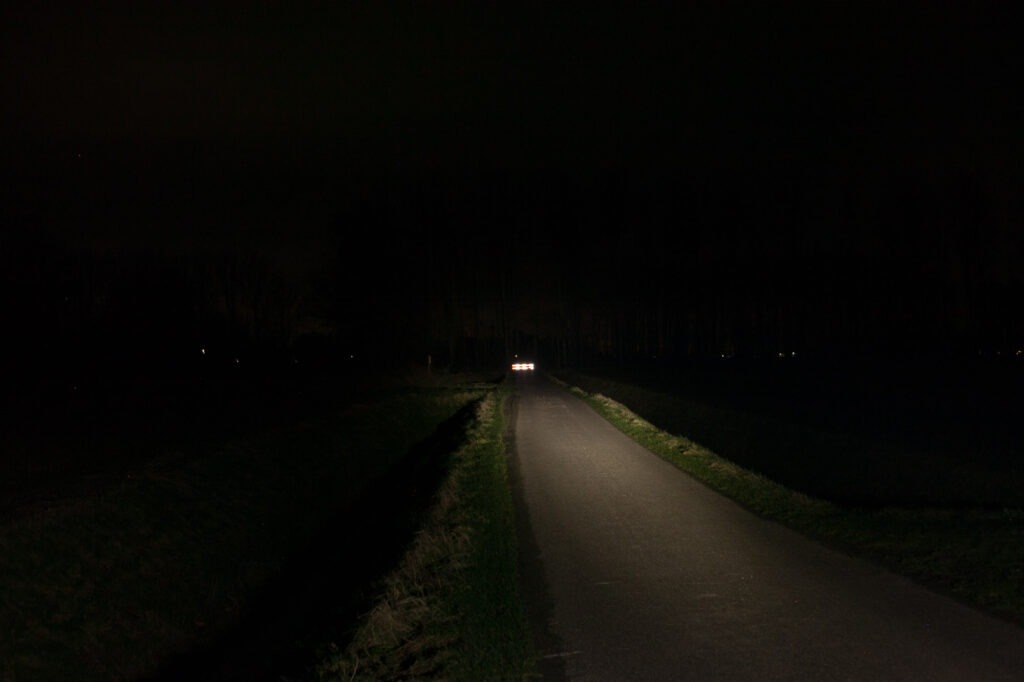
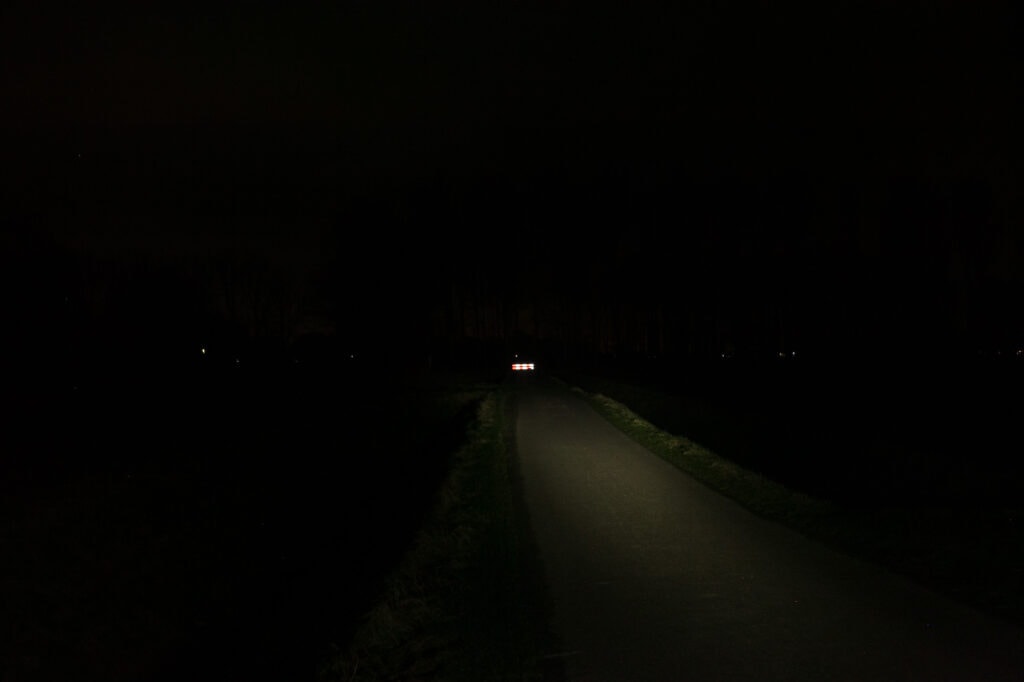
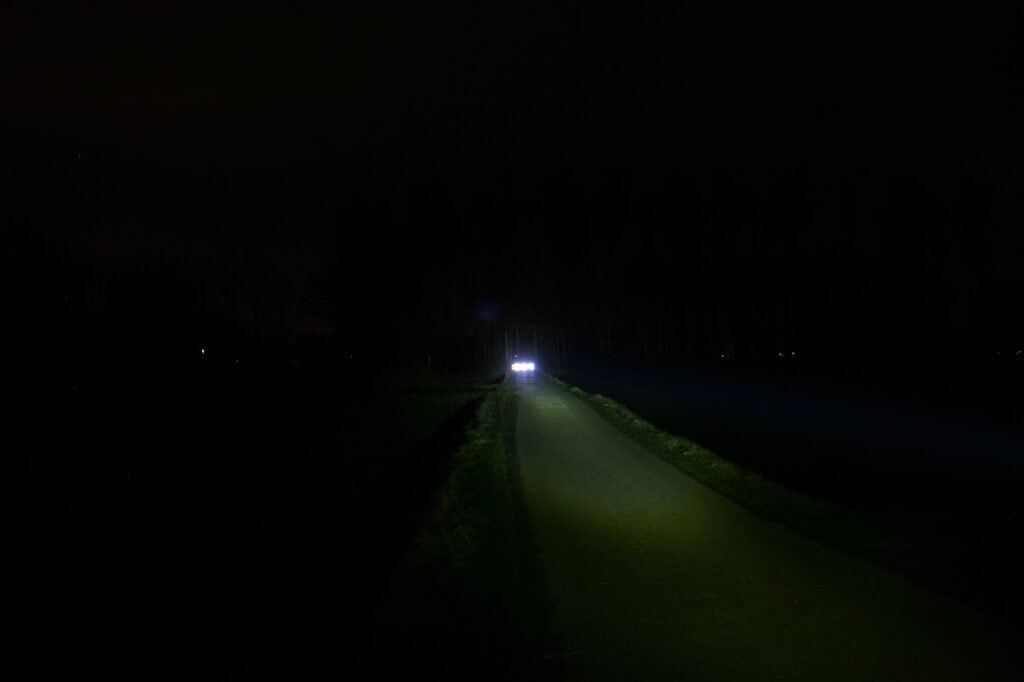
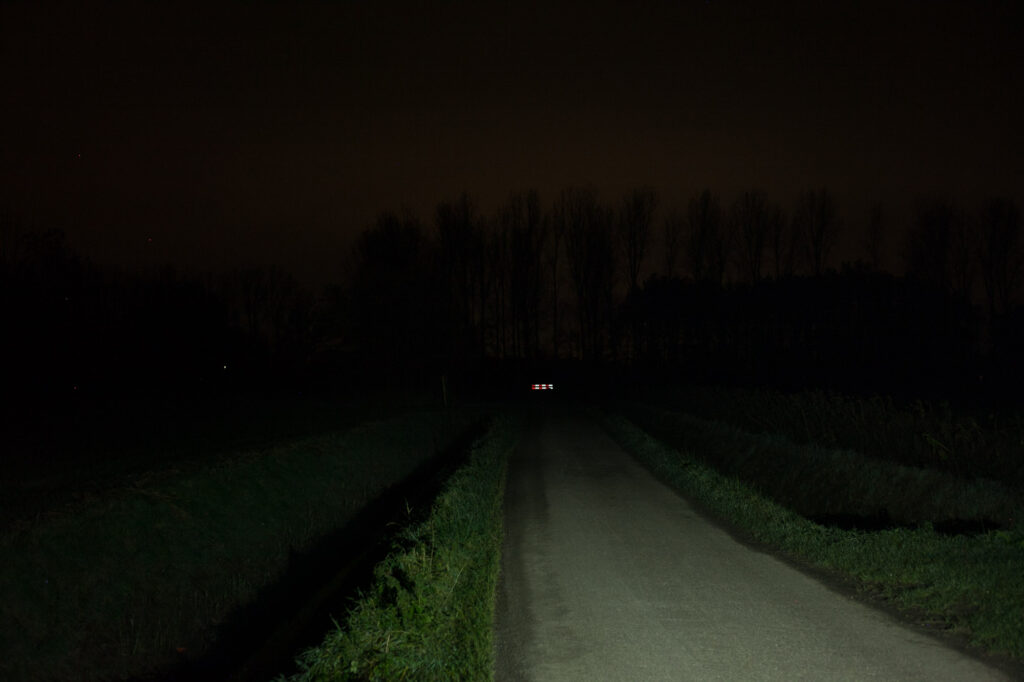
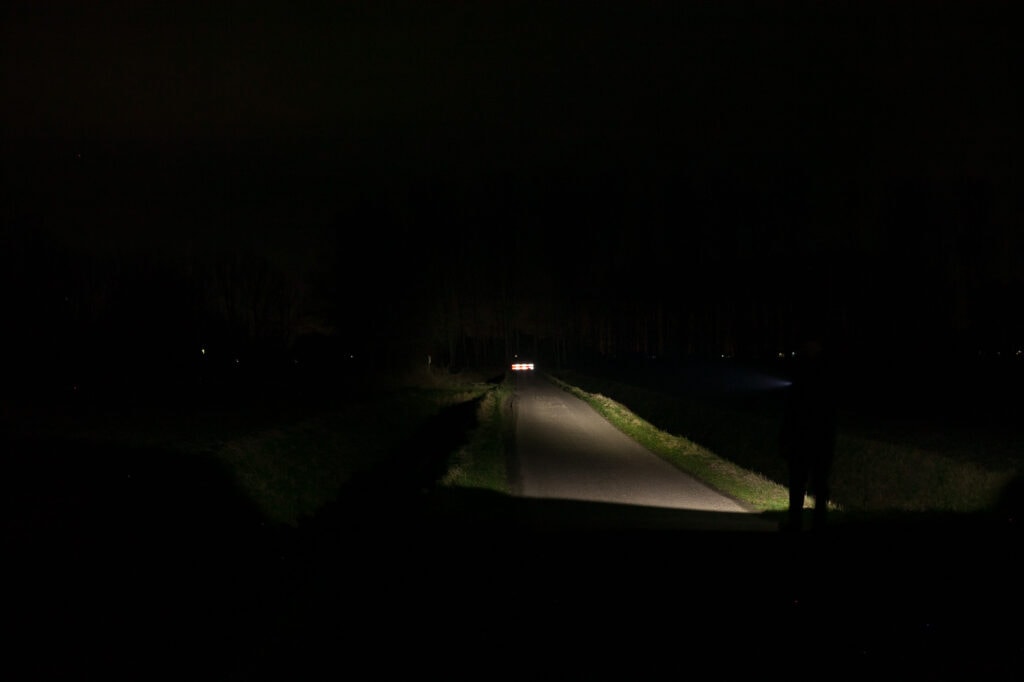
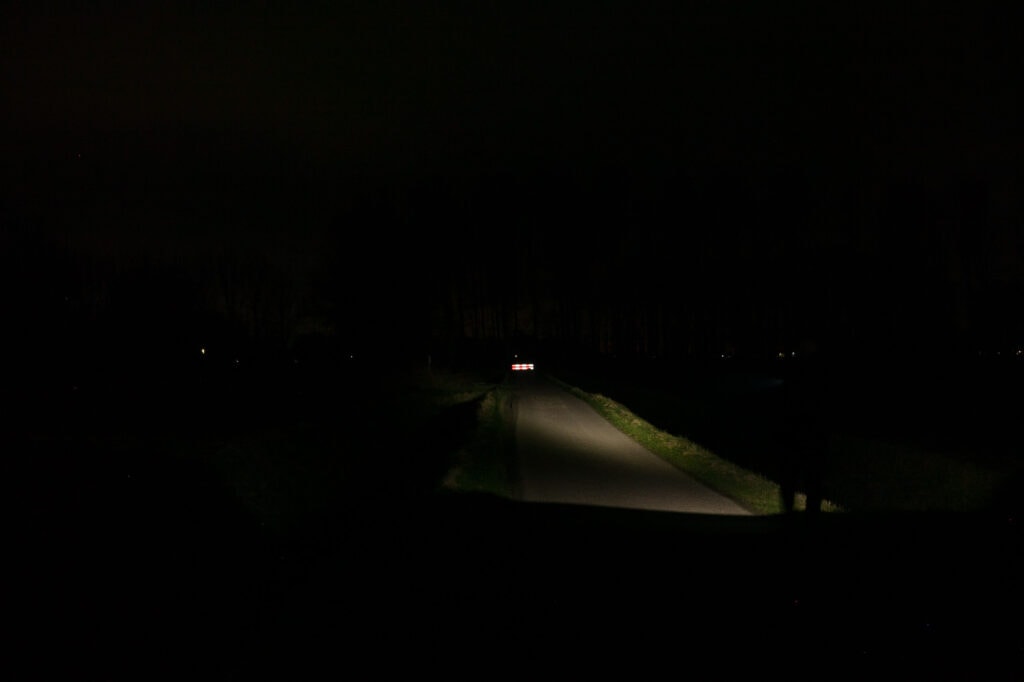
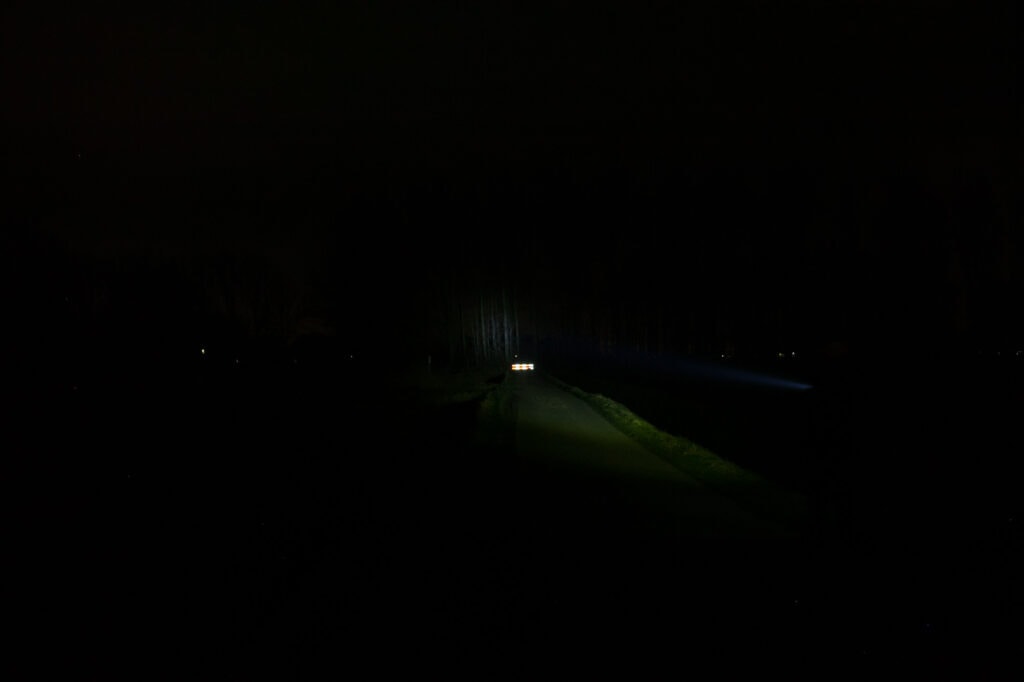

Disclaimer: This flashlight was sent to us for review at no cost by Weltool. We have not been paid to review, nor have we been holding back on problems or defects.
Final Verdict
Pros
- Affordable
- Small tactical-style flashlights
- Battery includes USB-C port
- Nice build quality
Cons
- Not reaching claimed output, distance
- No regulated, stable output
Explanation on star ratings:
1: Avoid: my phone flashlight would be a better choice – 2: Poor: significant defect or issues; almost unusable – 3: Average: some defects or issues; but still usable 4: Good: recommended (minor issues) – 5: Great: highly recommended

4.5 stars: ★★★★⋆
While our star rating provides a reliable indicator, we encourage you to read the full review to make an informed decision based on your own needs and preferences.
Weltool makes some really nice flashlights, and I think it’s fair to say that the T1 Pro TAC is an example of it. The build quality is great.
The T1 Pro Tac is a small tactical-style flashlight with only 1 mode. Well, not really, because there is a second, low mode, but hidden.
It’s throw capabilities are pretty remarkable for its size, and comparable to bigger flashlights.
The package includes a 14430 type (size of a normal 14500 battery) with built-in USB-C charging. That means you don’t have to buy a separate charger, and you can charge the battery on the fly.
I like its performance, although I would have preferred a regulated, stable output instead, especially for a tactical flashlight. Other than that, if you are looking for an AA-style flashlight, definitely consider the Weltool T1 Pro TAC
Buy your Weltool T1 Pro TAC here
1lumen selects and reviews products personally. We may earn affiliate commissions through our links, which help support our testing.